South Africa
What vaccines are needed for travel to south africa
Official websites use .gov
A .gov website belongs to an official government organization in the United States.
Secure .gov websites use HTTPS
A lock ( ) or https:// means you’ve safely connected to the .gov website. Share sensitive information only on official, secure websites.
![South Africa [shutterstock]](https://www.state.gov/wp-content/uploads/2018/11/South-Africa-e1555938663342-2501x1406.jpg)
- View Fact Sheet
- Embassies & Consulates
- Bureau of African Affairs
International Travel Information
What you need to know before you go: visas, embassy & consulate locations, vaccinations, etc.
Current Travel Advisories
Level 2: Exercise Increased Caution

COVID-19 Vaccine Distribution
Since July, 2021 the United States has shared 7,877,610 safe and effective COVID-19 vaccine doses with the people of South Africa – free of cost. This includes 7,877,610 Pfizer doses. Of the 7,877,610 vaccine doses, 100% were donated in partnership with COVAX.
President Biden committed the United States to be the world’s arsenal for vaccines, leading an international and coordinated vaccination effort, and announced that the United States will provide 1.2 billion doses of safe, effective vaccines – free of cost – to meet global needs and save lives now. The United States is working with other governments, global initiatives including COVAX and the African Vaccine Acquisition Trust (AVAT), and other partners to get COVID-19 vaccines to where they are needed most.
Highlights
U.S. Relationship
- U.S.-South Africa Relations
- U.S. Assistance to South Africa
- Bilateral Economic Relations
U.S.-South Africa Relations
Since South Africa’s transition to democracy in 1994, the United States and South Africa have enjoyed a solid bilateral relationship. South Africa is a strategic partner of the United States, with strong collaboration in the areas of health, education, environment, and digital economy.
The United States first opened a consulate in Cape Town in 1799, and in 1929 established formal diplomatic relations with South Africa after the United Kingdom recognized South Africa’s autonomy within the British Empire. In 1948, the South African government instituted apartheid, which involved policies of racial segregation and white domination over the black majority and other non-white groups. U.S.-South Africa relations became severely strained by South Africa’s racial policies, leading the U.S. Congress to pass the 1986 Comprehensive Anti-Apartheid Act, which imposed sanctions on the apartheid South African government.
The United States played an important role in support of South Africa’s 1994 democratic transition. In October 1994, U.S. President Bill Clinton received newly elected President Nelson Mandela on his first state visit to the United States with a State Dinner and public appearances. In 1995, the U.S.-South African Binational Commission was launched to support the rebuilding of South Africa, and U.S. President Bill Clinton visited South Africa in 1998. The United States and South Africa share strong educational and people-to-people ties, significant economic and political interests, as well as common development objectives throughout Africa. As a strong democracy and sub-Saharan Africa’s most developed economy, South Africa plays a key economic and political role on the African continent. The United States seeks opportunities for increased U.S.-South African cooperation on regional and international issues.
U.S. Assistance to South Africa
Since 1994, South Africa has made notable strides toward building an inclusive democracy that provides increased opportunity for its people. Nevertheless, the country faces many challenges, including slow economic growth, high rates of crime and unemployment, lingering corruption, and a persistent HIV/AIDS epidemic. U.S. assistance focuses on improving healthcare, increasing education standards and teacher training, building capacity in agriculture to address regional food security, developing clean energy, and adapting to changing weather patterns.
Since 2004, the U.S. government has invested more than $6.2 billion in assistance through the President’s Emergency Plan for AIDS Relief (PEPFAR) in South Africa’s HIV response to ensure that all South Africans can live longer, healthier lives. U.S. Agency for International Development (USAID) programs seek to strengthen small- and medium-sized enterprises, create employment, improve learning and job skills, promote basic education, combat gender-based violence, and promote HIV/AIDS care, prevention, and treatment.
Bilateral Economic Relations
South Africa is the largest U.S. trade partner in Africa, with a total two-way goods trade of $14 billion in 2018. Approximately 600 U.S. businesses operate in South Africa, many of which use South Africa as regional headquarters. South Africa qualifies for preferential trade benefits under the African Growth and Opportunity Act as well as the U.S. Generalized System of Preferences trade preference program. Both governments engage in frequent discussions to increase opportunities for bilateral trade and investment and optimize the business climate. The United States and South Africa signed an amended Trade and Investment Framework Agreement (TIFA) in 2012. In addition, the country belongs to the Southern African Customs Union, which signed a Trade, Investment, and Development Cooperative Agreement (TIDCA) with the United States in 2008. The United States and South Africa have a bilateral tax treaty eliminating double taxation.
Table of Contents
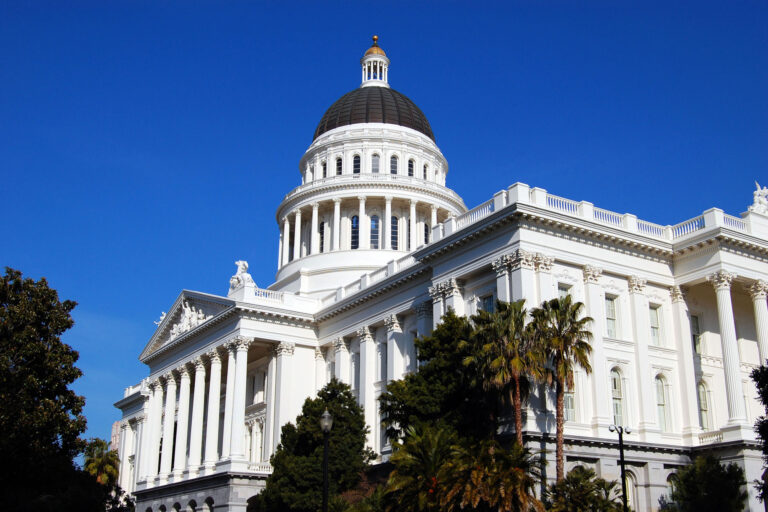
California voters have now received their mail ballots, and the November 8 general election has entered its final stage. Amid rising prices and economic uncertainty—as well as deep partisan divisions over social and political issues—Californians are processing a great deal of information to help them choose state constitutional officers and state legislators and to make policy decisions about state propositions. The 2022 midterm election also features a closely divided Congress, with the likelihood that a few races in California may determine which party controls the US House.
These are among the key findings of a statewide survey on state and national issues conducted from October 14 to 23 by the Public Policy Institute of California:
- Many Californians have negative perceptions of their personal finances and the US economy. Seventy-six percent rate the nation’s economy as “not so good” or “poor.” Thirty-nine percent say their finances are “worse off” today than a year ago. Forty-seven percent say that things in California are going in the right direction, while 33 percent think things in the US are going in the right direction; partisans differ in their overall outlook.→
- Among likely voters, 55 percent would vote for Gavin Newsom and 36 percent would vote for Brian Dahle if the governor’s election were today. Partisans are deeply divided in their choices. Sixty percent are very or fairly closely following news about the governor’s race. Sixty-two percent are satisfied with the candidate choices in the governor’s election.→
- When likely voters are read the ballot title and labels, 34 percent would vote yes on Proposition 26 (sports betting at tribal casinos), 26 percent would vote yes on Proposition 27 (online sports gambling),and 41 percent would vote yes on Proposition 30 (reducing greenhouse gases). Most likely voters say they are not personally interested in sports betting, and 48 percent think it would be a “bad thing” if it became legal in the state. Fewer than half of likely voters say the vote outcome of Propositions 26, 27, or 30 is very important to them.→
- Fifty-six percent of likely voters would support the Democratic candidate in their US House race if the election were today. Sixty-one percent say the issue of abortion rights is very important in their vote for Congress this year; Democrats are far more likely than Republicans or independents to hold this view. About half are “extremely” or “very” enthusiastic about voting for Congress this year; 54 percent of Republicans and Democrats, and 41 percent of independents, are highly enthusiastic this year.→
- Forty-five percent of Californians and 40 percent of likely voters are satisfied with the way that democracy is working in the United States. Republicans are far less likely than Democrats and independents to hold this positive view. There is rare partisan consensus on one topic: majorities of Democrats, Republicans, and independents are pessimistic that Americans with different political views can still come together and work out their differences.→
- Majorities of California adults and likely voters approve of Governor Gavin Newsom and President Joe Biden. About four in ten or more California adults and likely voters approve of US Senator Dianne Feinstein and US Senator Alex Padilla. These approval ratings vary across partisan groups. Approval of the state legislature is higher than approval of the US Congress.→
Overall Mood
With less than two weeks to go until what is set to be a highly consequential midterm election, California adults are divided on whether the state is generally headed in the right direction (47%) or wrong direction (48%); a majority of likely voters (54%) think the state is headed in the wrong direction (43% right direction). Similar shares held this view last month (wrong direction: 44% adults, 49% likely voters; right direction: 50% adults, 48% likely voters). Today, there is a wide partisan divide: seven in ten Democrats are optimistic about the direction of the state, while 91 percent of Republicans and 59 percent of independents are pessimistic. Majorities of residents in the Central Valley and Orange/San Diego say the state is going in the wrong direction, while a majority in the San Francisco Bay Area say right direction; adults elsewhere are divided. Across demographic groups, Californians ages 18 to 34 (60%), Asian Americans (52%), college graduates (52%), renters (52%), and women (52%) are the only groups in which a majority are optimistic about California’s direction.
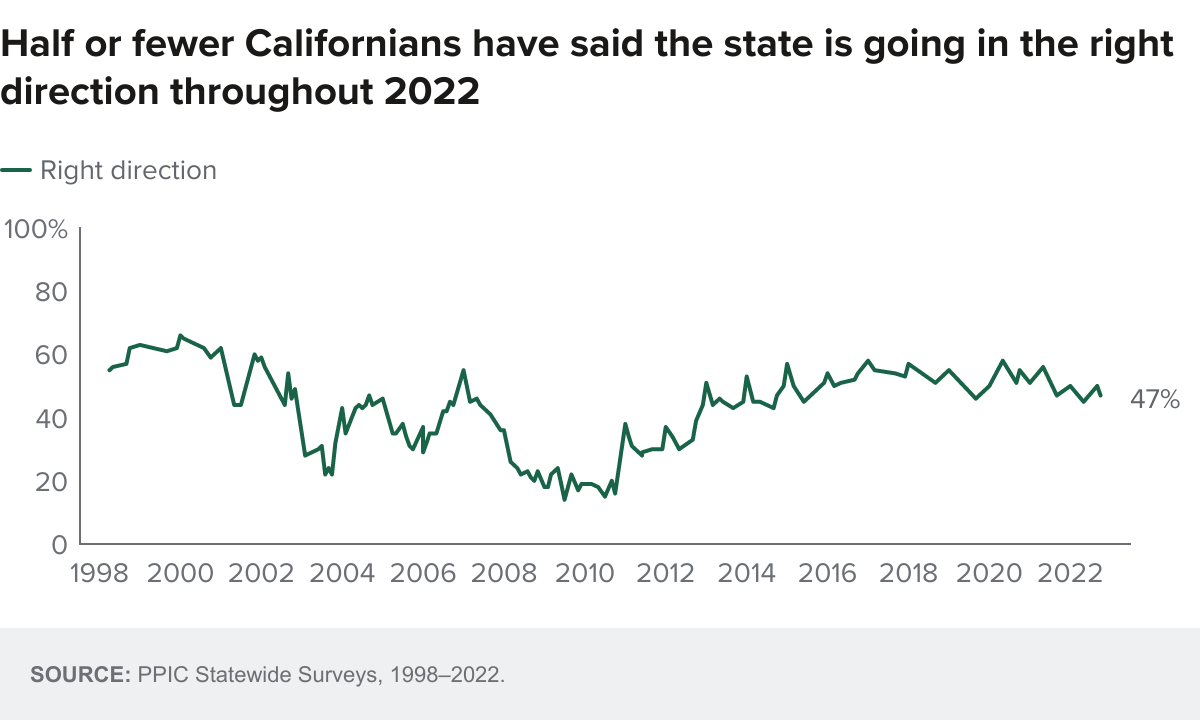
Californians are much more pessimistic about the direction of the country than they are about the direction of the state. Solid majorities of adults (62%) and likely voters (71%) say the United States is going in the wrong direction, and majorities have held this view since September 2021. One in three or fewer adults (33%) and likely voters (25%) think the country is going in the right direction. Majorities across all demographic groups and partisan groups, as well as across regions, are pessimistic about the direction of the United States.
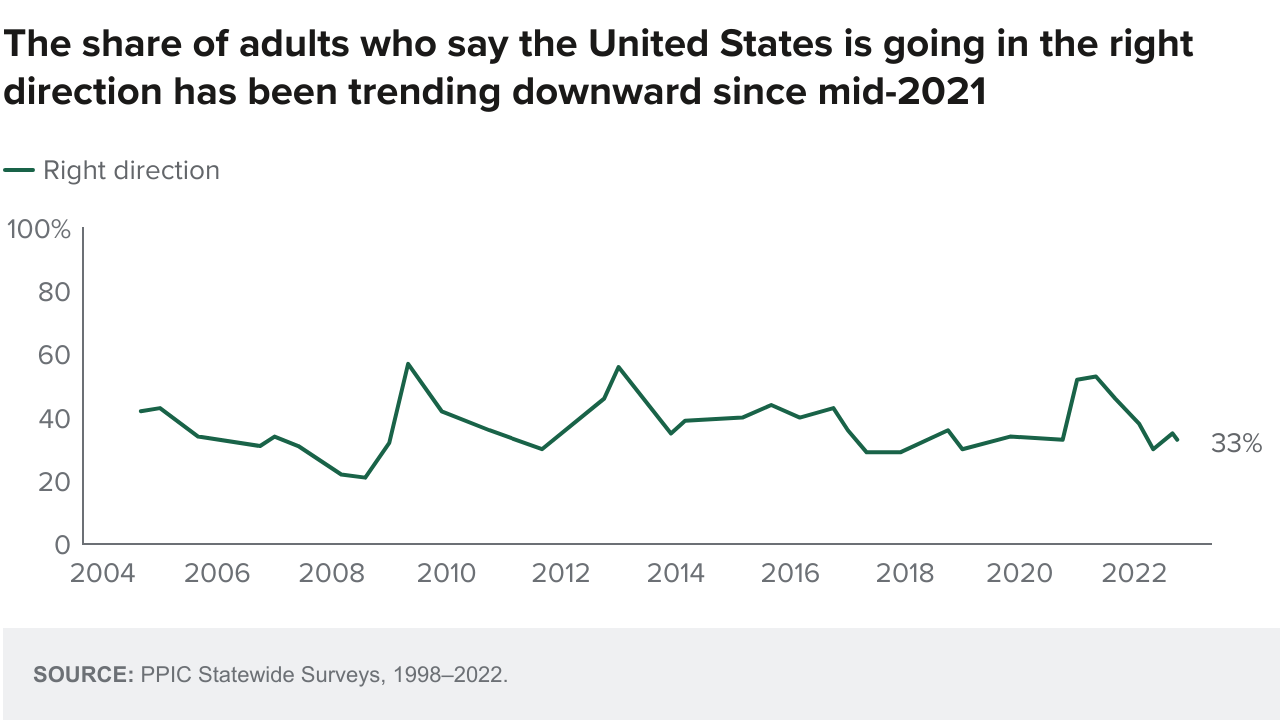
The state of the economy and inflation are likely to play a critical role in the upcoming election, and about four in ten adults (39%) and likely voters (43%) say they and their family are worse off financially than they were a year ago. Similar shares say they are financially in about the same spot (43% adults, 44% likely voters). The share who feel they are worse off has risen slightly among likely voters since May, but is similar among adults (37% adults, 36% likely voters). Fewer than two in ten Californians say they are better off than they were one year ago (17% adults, 13% likely voters). A wide partisan divide exists: most Democrats and independents say their financial situation is about the same as a year ago, while solid majorities of Republicans say they are worse off. Regionally, about half in the San Francisco Bay Area and Los Angeles say they are about the same, while half in the Central Valley say they are worse off; residents elsewhere are divided between being worse off and the same. Across demographic groups, pluralities say they are either financially about the same as last year or worse off, with the exception of African Americans (51% about the same, 33% worse off, 16% better off) and Asian Americans (51% about the same, 27% worse off, 20% better off). The shares saying they are worse off decline as educational attainment increases.
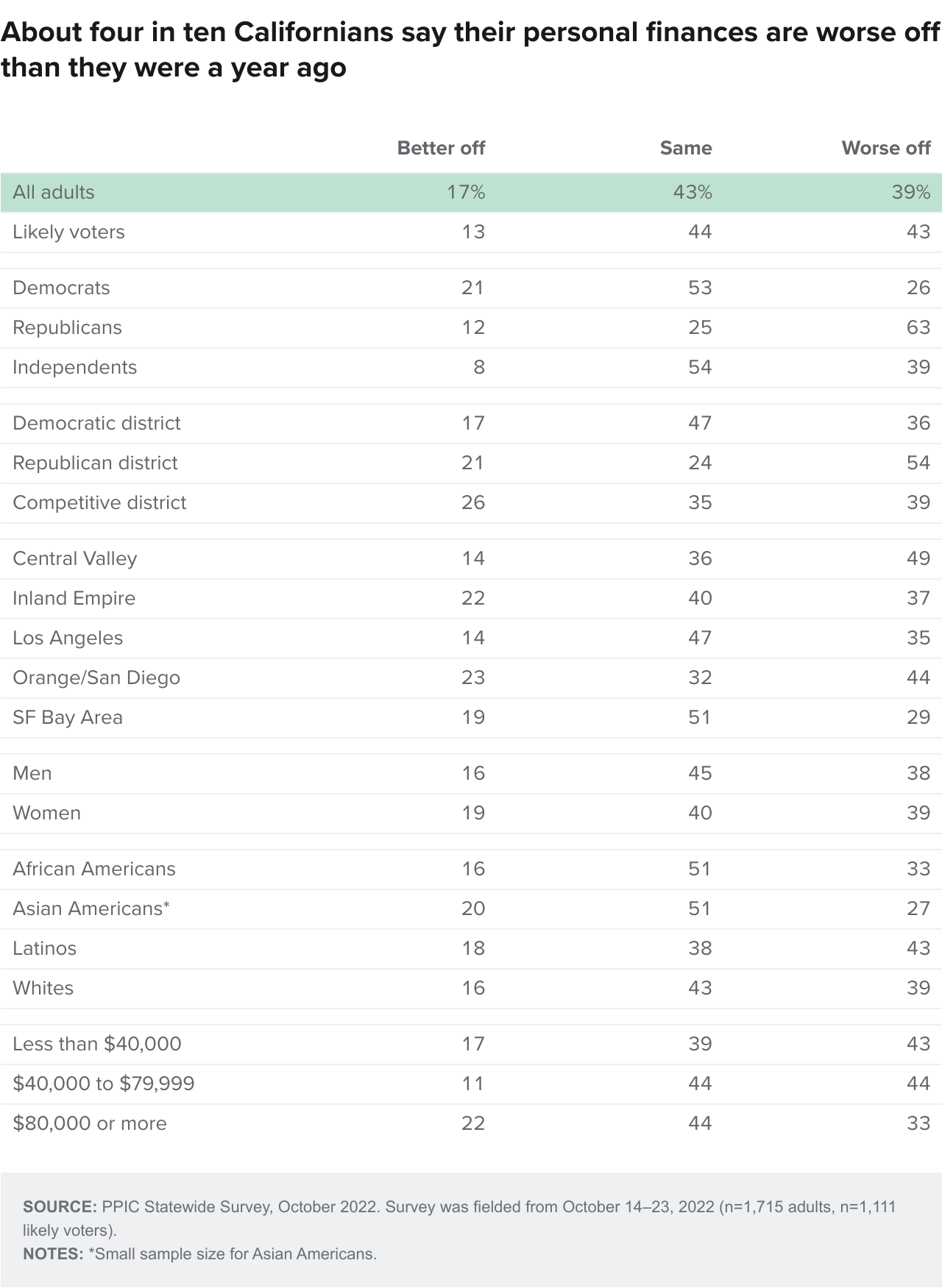
With persistent inflation and concerns about a possible recession in the future, an overwhelming majority of Californians believe the US economy is in not so good (43% adults, 40% likely voters) or poor (33% adults, 36% likely voters) shape. About a quarter of adults (3% excellent, 20% good) and likely voters (2% excellent, 23% good) feel positively about the national economy. Strong majorities across partisan groups feel negatively, but Republicans and independents are much more likely than Democrats to say the economy is in poor shape. Solid majorities across the state’s major regions as well as all demographic groups say the economy is in not so good or poor shape. In a recent ABC News/Washington Post poll, 24 percent (3% excellent, 21% good) of adults nationwide felt positively about the US economy, while 74 percent (36% not so good, 38% poor) expressed negative views.
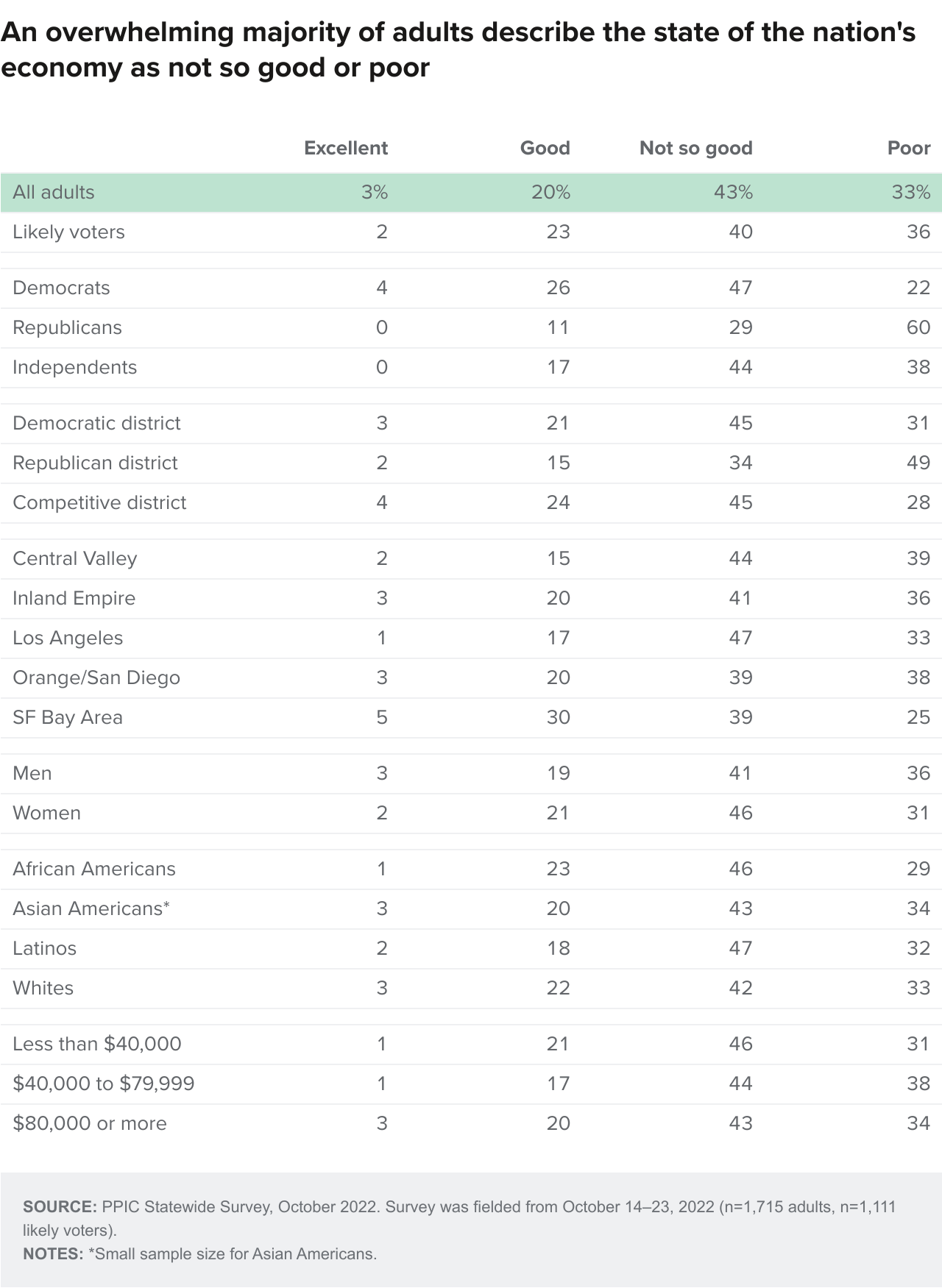
Gubernatorial Election
Six in ten likely voters say they are following news about the 2022 governor’s race very (25%) or fairly (35%) closely—a share that has risen from half just a month ago (17% very, 33% fairly). This finding is somewhat similar to October 2018, when 68 percent said this (28% very, 40% closely) a month before the previous gubernatorial election. Today, majorities across partisan, demographic, and regional groups say they are following news about the gubernatorial election either very or fairly closely. The shares saying they are following the news very closely is highest among residents in Republican districts (39%), Republicans (30%), whites (29%), and adults with incomes of $40,000 to $79,999 (29%). Older likely voters (27%) are slightly more likely than younger likely voters (21%) to say they are following the news closely.
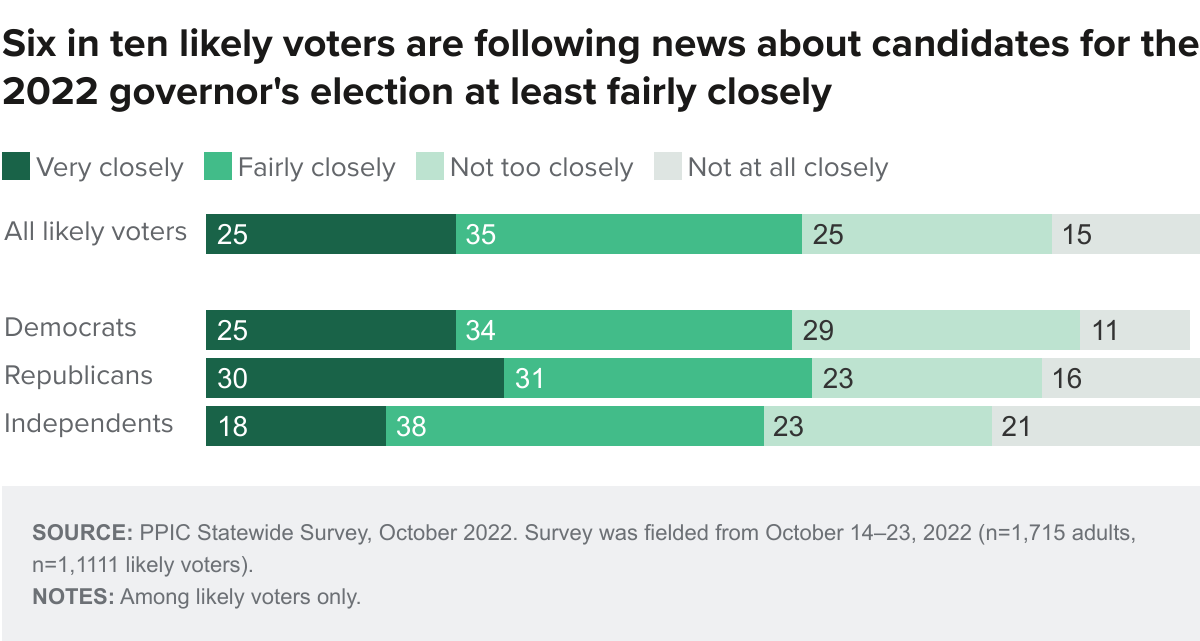
Democratic incumbent Gavin Newsom is ahead of Republican Brian Dahle (55% to 36%) among likely voters, while few say they would not vote, would vote for neither, or don’t know who they would vote for in the governor’s race. The share supporting the reelection of the governor was similar a month ago (58% Newsom, 31% Dahle). Today, Newsom enjoys the support of most Democrats (91%), while most Republicans (86%) support Dahle; Newsom has an edge over Dahle among independent likely voters (47% Newsom, 37% Dahle). Across the state’s regions, two in three in the San Francisco Bay Area and Los Angeles support Newsom, as do nearly half in the Inland Empire and Orange/San Diego; likely voters in the Central Valley are split. Newsom leads in all demographic groups, with the exception of men (45% Newsom, 44% Dahle) and those with a high school diploma only (46% Newsom, 49% Dahle). The share supporting Newsom grows as educational attainment increases (46% high school only, 56% some college, 60% college graduates), while it decreases with rising income (64% less than $40,000, 56% $40,000 to $79,999, 52% $80,000 or more).
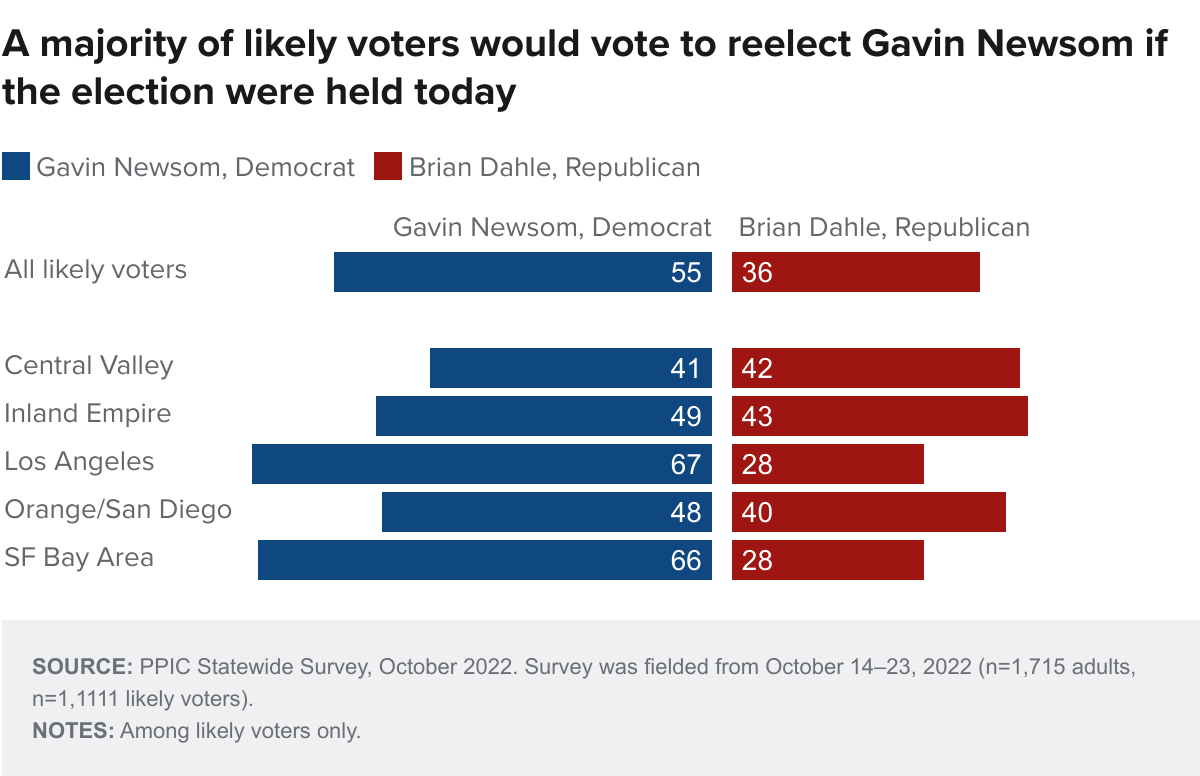
A solid majority of likely voters (62%) are satisfied with their choices of candidates in the November 8 election, while about three in ten (32%) are not satisfied. Shares expressing satisfaction have increased somewhat from a month ago (53%) and were similar prior to the 2018 gubernatorial election (60% October 2018). Today, a solid majority of Democrats (79%) and independents (61%) say they are satisfied, compared to fewer than half of Republicans (44%). Majorities across demographic groups say they are satisfied, and notably, women (68%) are more likely than men (56%) to say this. Majorities across the state’s regions say they are satisfied with their choices of candidates in the upcoming gubernatorial election.
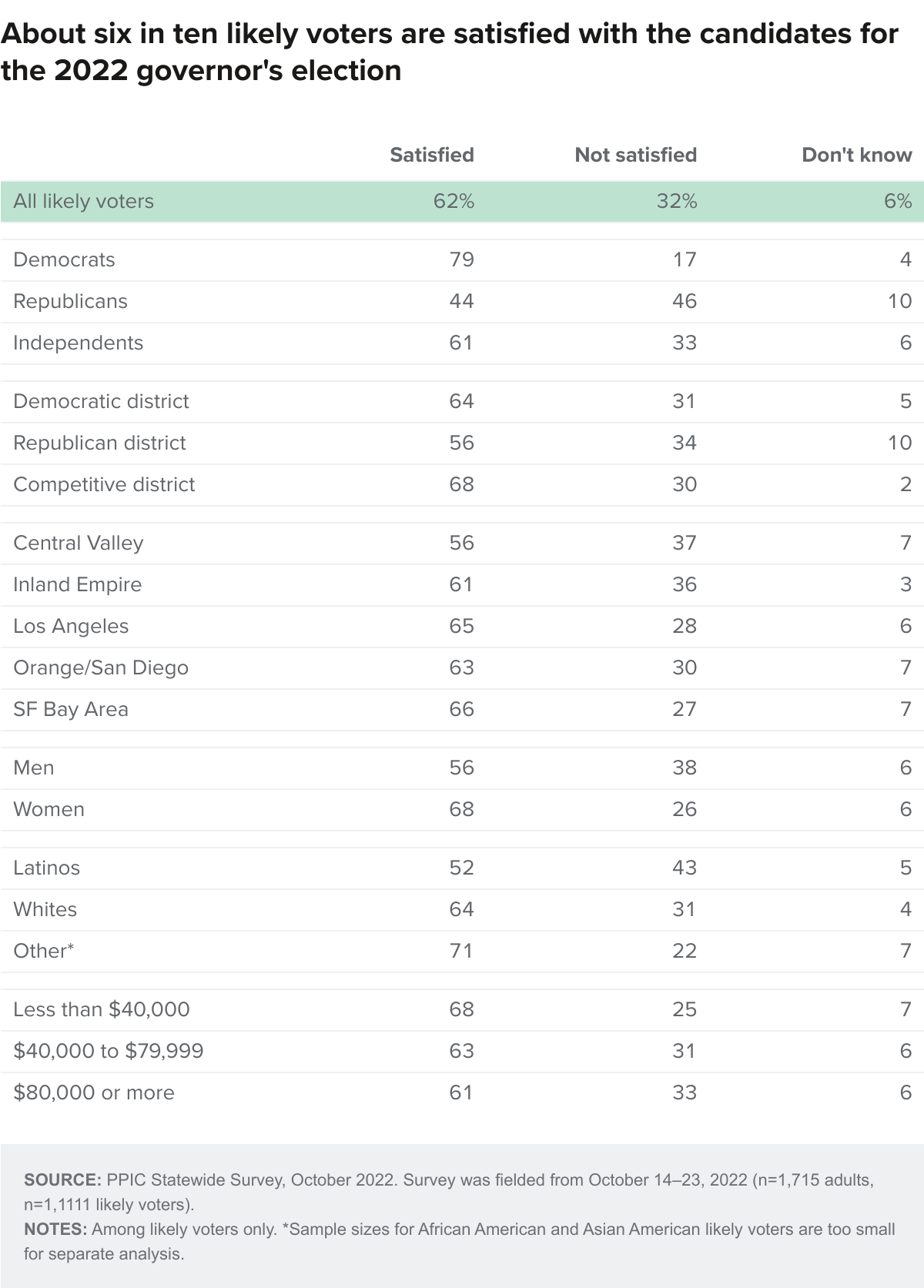
State Propositions 26, 27, and 30
In the upcoming November 8 election, there will be seven state propositions for voters. Due to time constraints, our survey only asked about three ballot measures: Propositions 26, 27, and 30. For each, we read the proposition number, ballot, and ballot label. Two of the state ballot measures were also included in the September survey (Propositions 27 and 30), while Proposition 26 was not.
If the election were held today, 34 percent of likely voters would vote “yes,” 57 percent would vote “no,” and 9 percent are unsure of how they would vote on Proposition 26—Allows In-Person Roulette, Dice, Game, Sports Wagering on Tribal Lands. This measure would allow in-person sports betting at racetracks and tribal casinos, requiring that racetracks and casinos offering sports betting make certain payments to the state to support state regulatory costs. It also allows roulette and dice games at tribal casinos and adds a new way to enforce certain state gambling laws. There is partisan agreement on Prop 26: fewer than four in ten Democrats, Republicans, and independents would vote “yes.” Moreover, less than a majority across all regions and demographic groups—with the exception of likely voters ages 18 to 44 (51% yes, 44% no)—would vote “yes.”
If the election were held today, 26 percent of likely voters would vote “yes,” 67 percent would vote “no,” and 8 percent are unsure of how they would vote on Proposition 27—Allows Online and Mobile Sports Wagering Outside Tribal Lands. This citizens’ initiative would allow Indian tribes and affiliated businesses to operate online and mobile sports wagering outside tribal lands. Strong majorities across partisan groups would vote “no” on Prop 27. The share voting “yes” has decreased since a month ago (34% September). Today, fewer than three in ten across partisan groups would vote “yes” on Prop 27. Moreover, fewer than four in ten across regions, gender, racial/ethnic, education, and income groups would vote “yes.” Likely voters ages 18 to 44 (41%) are far more likely than older likely voters ages 45 and above (19%) to say they would vote “yes.”
If the election were held today, 41 percent of likely voters would vote “yes,” 52 percent would vote “no,” and 7 percent are unsure of how they would vote on Proposition 30—Provides Funding for Programs to Reduce Air Pollution and Prevent Wildfires by Increasing Tax on Personal Income over $2 Million. This citizens’ initiative would increase taxes on Californians earning more than $2 million annually and allocate that tax revenue to zero-emission vehicle purchase incentives, vehicle charging stations, and wildfire prevention. The share saying “yes” on Prop 30 has decreased from 55 percent in our September survey (note: since September, Governor Newsom has been featured in “no on Prop 30” commercials). Today, unlike Prop 26 and Prop 27, partisan opinions are divided on Prop 30: 61 percent of Democrats would vote “yes,” compared to far fewer Republicans (15%) and independents (38%). Across regions, and among men and women, support falls short of a majority (36% men, 45% women). Fewer than half across racial/ethnic groups say they would vote “yes” (39% whites, 42% Latinos, 46% other racial/ethnic groups). Just over half of likely voters with incomes under $40,000 (52%) would vote “yes,” compared to fewer in higher-income groups (42% $40,000 to $79,999, 36% $80,000 or more). Nearly half of likely voters ages 18 to 44 (49%) would vote “yes,” compared to 37 percent of older likely voters.
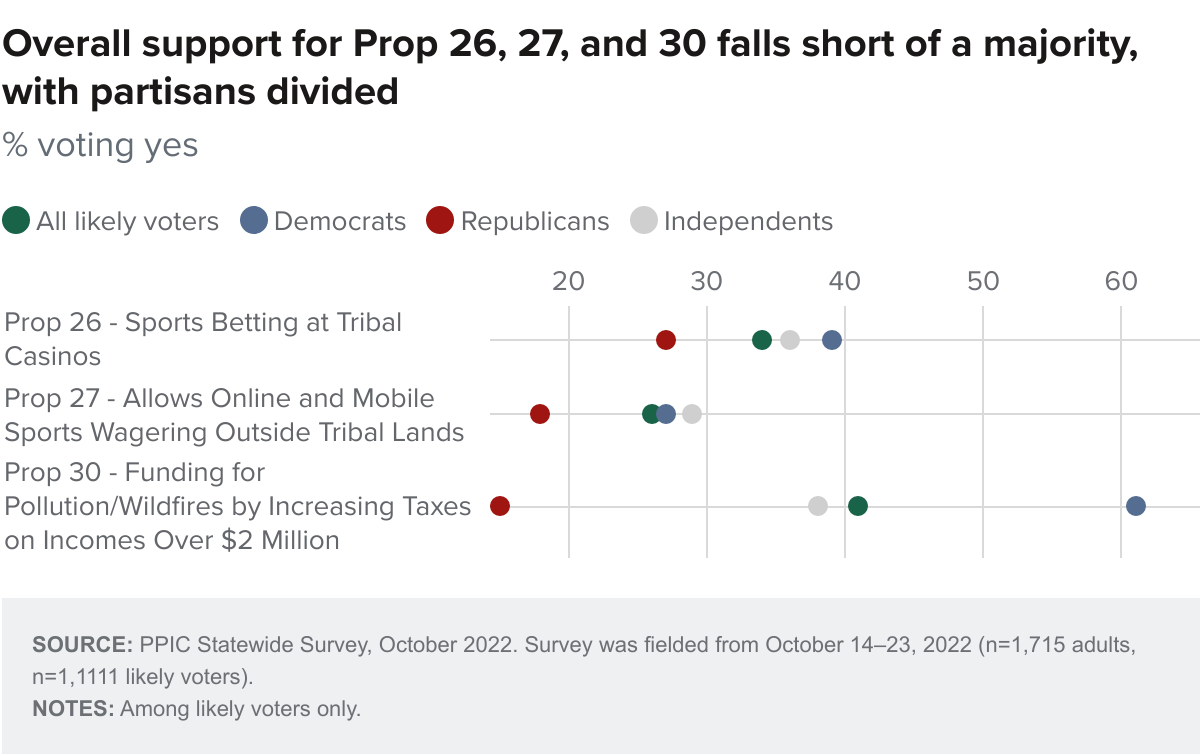
Fewer than half of likely voters say the outcome of each of these state propositions is very important to them. Today, 21 percent of likely voters say the outcome of Prop 26 is very important, 31 percent say the outcome of Prop 27 is very important, and 42 percent say the outcome of Prop 30 is very important. The shares saying the outcomes are very important to them have remained similar to a month ago for Prop 27 (29%) and Prop 30 (42%). Today, when it comes to the importance of the outcome of Prop 26, one in four or fewer across partisan groups say it is very important to them. About one in three across partisan groups say the outcome of Prop 27 is very important to them. Fewer than half across partisan groups say the outcome of Prop 30 is very important to them.
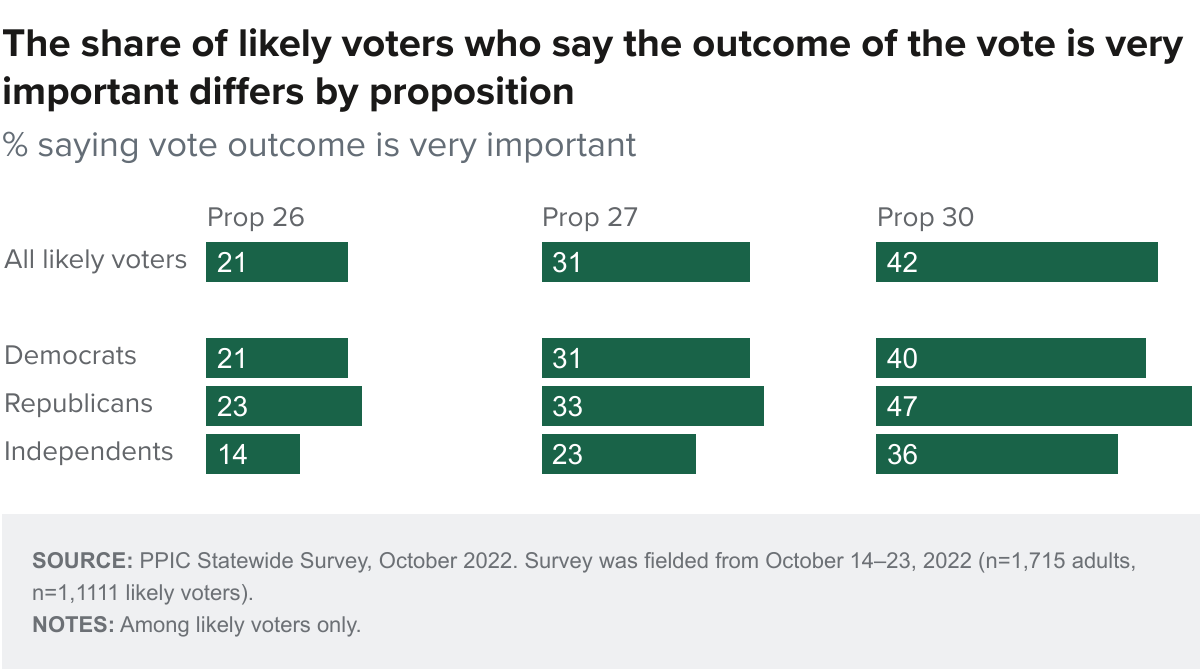
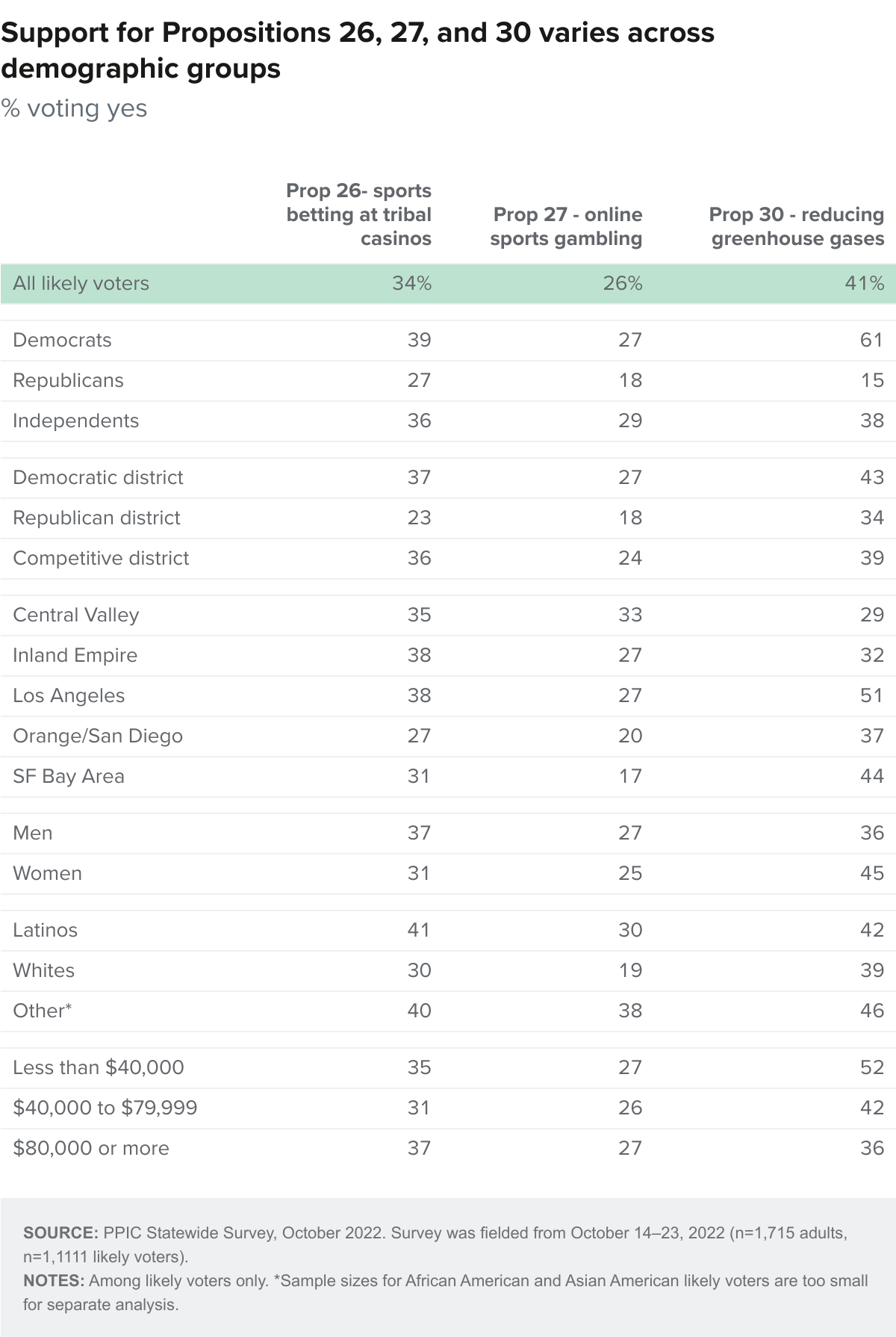
Congressional Elections
When asked how they would vote if the 2022 election for the US House of Representatives were held today, 56 percent of likely voters say they would vote for or lean toward the Democratic candidate, while 39 percent would vote for or lean toward the Republican candidate. In September, a similar share of likely voters preferred the Democratic candidate (60% Democrat/lean Democrat, 34% Republican/lean Republican). Today, overwhelming majorities of partisans support their party’s candidate, while independents are divided (50% Democrat/lean Democrat, 44% Republican/lean Republican). Democratic candidates are preferred by a 26-point margin in Democratic-held districts, while Republican candidates are preferred by a 23-point margin in Republican-held districts. In the ten competitive California districts as defined by the Cook Political Report, the Democratic candidate is preferred by a 22-point margin (54% to 32%).
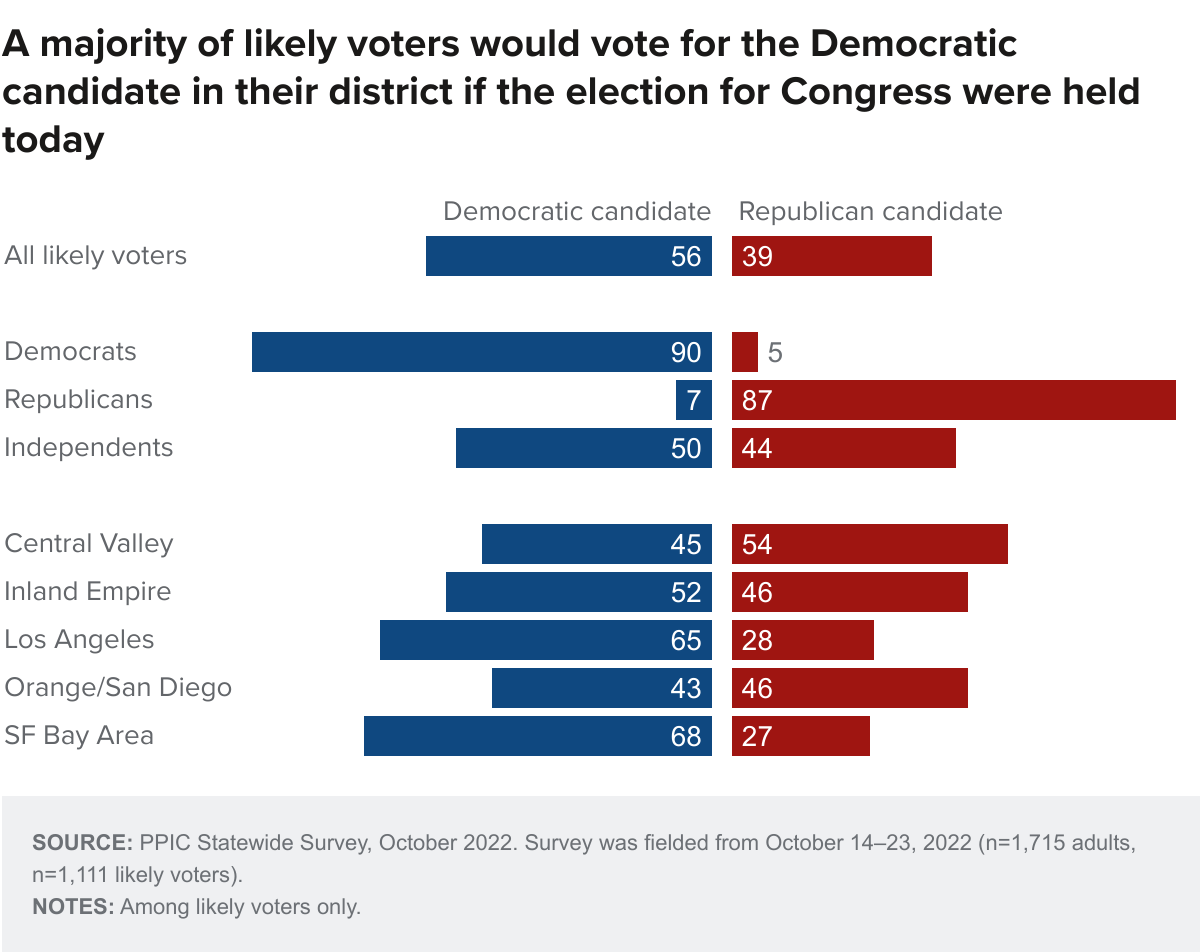
Abortion is another prominent issue in this election. When asked about the importance of abortion rights, 61 percent of likely voters say the issue is very important in determining their vote for Congress and another 20 percent say it is somewhat important; just 17 percent say it is not too or not at all important. Among partisans, an overwhelming majority of Democrats (78%) and 55 percent of independents say it is very important, compared to 43 percent of Republicans. Majorities across regions and all demographic groups—with the exception of men (49% very important)—say abortion rights are very important when making their choice among candidates for Congress.

With the controlling party in Congress hanging in the balance, 51 percent of likely voters say they are extremely or very enthusiastic about voting for Congress this year; another 29 percent are somewhat enthusiastic while 19 percent are either not too or not at all enthusiastic. In October 2018 before the last midterm election, a similar 53 percent of likely voters were extremely or very enthusiastic about voting for Congress (25% extremely, 28% very, 28% somewhat, 10% not too, 8% not at all). Today, Democrats and Republicans have about equal levels of enthusiasm, while independents are much less likely to be extremely or very enthusiastic. Half or more across regions are at least very enthusiastic, with the exceptions of likely voters in Los Angeles (44%) and the San Francisco Bay Area (43%). At least half across demographic groups are highly enthusiastic, with the exceptions of likely voters earning $40,000 to $79,999 annually (48%), women (47%), Latinos (43%), those with a high school diploma or less (42%), renters (42%), and 18- to 44-year-olds (37%).
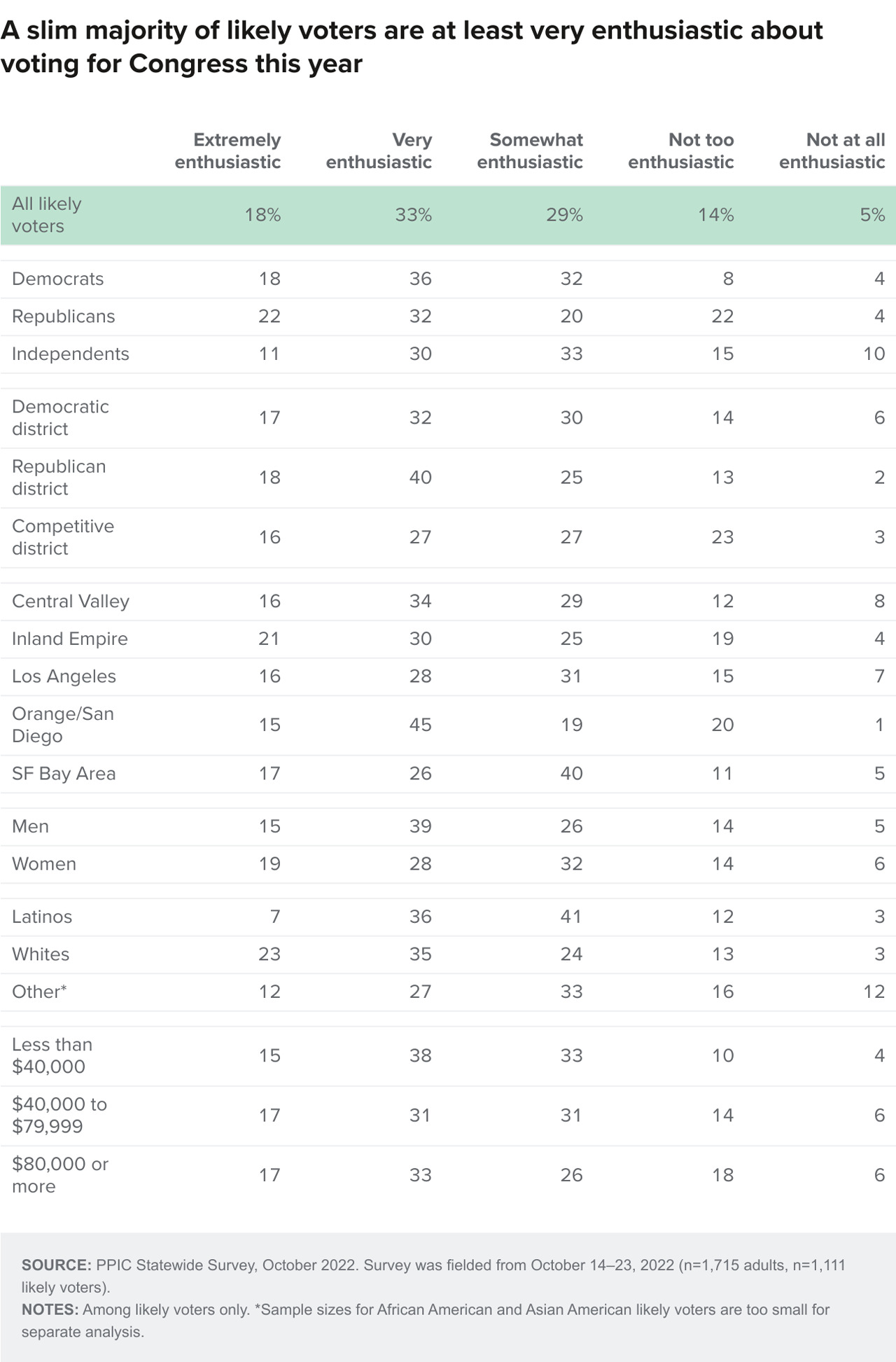
Democracy and the Political Divide
As Californians prepare to vote in the upcoming midterm election, fewer than half of adults and likely voters are satisfied with the way democracy is working in the United States—and few are very satisfied. Satisfaction was higher in our February survey when 53 percent of adults and 48 percent of likely voters were satisfied with democracy in America. Today, half of Democrats and about four in ten independents are satisfied, compared to about one in five Republicans. Notably, four in ten Republicans are not at all satisfied. Across regions, half of residents in the San Francisco Bay Area (52%) and the Inland Empire (50%) are satisfied, compared to fewer elsewhere. Across demographic groups, fewer than half are satisfied, with the exception of Latinos (56%), those with a high school degree or less (55%), and those making less than $40,000 (53%).
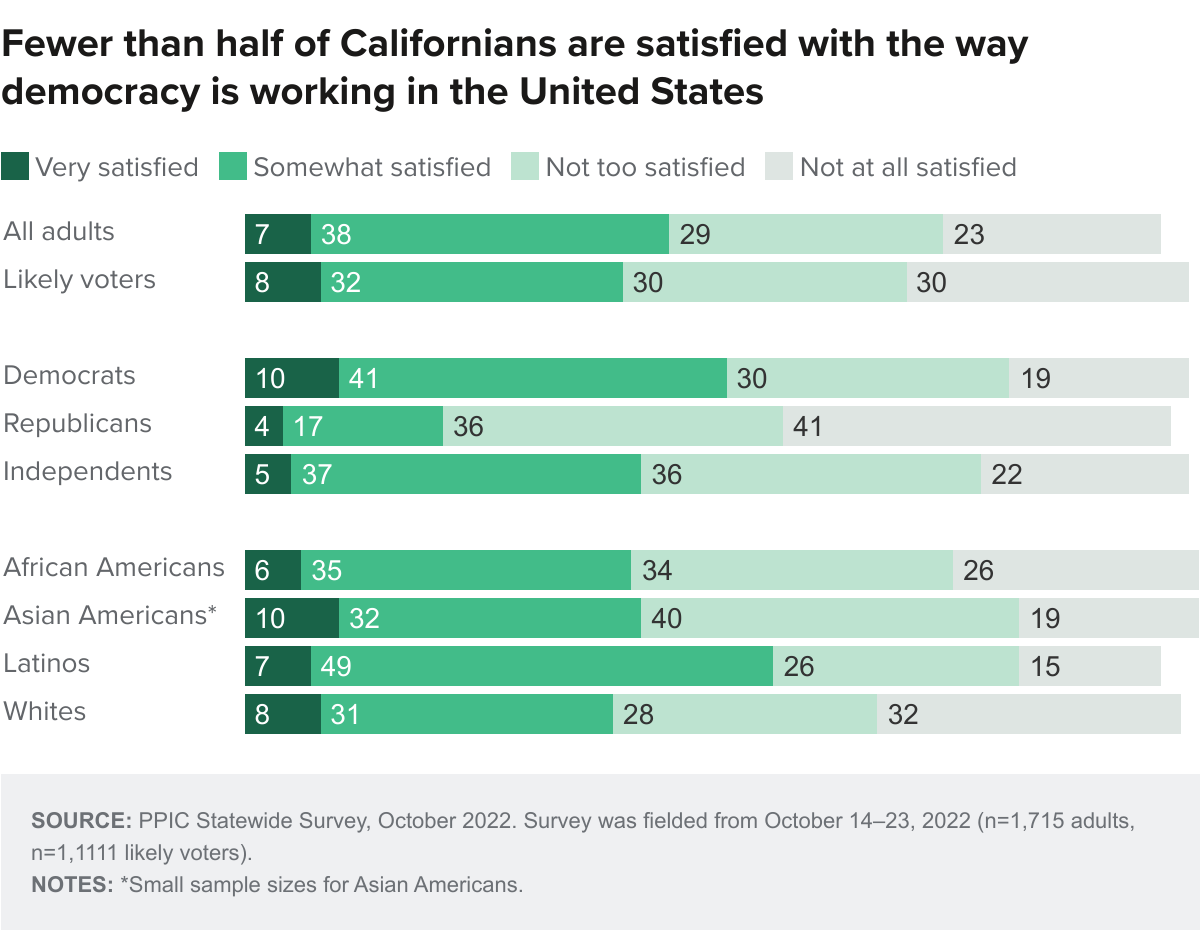
In addition to the lack of satisfaction with the way democracy is working, Californians are divided about whether Americans of different political positions can still come together and work out their differences. Forty-nine percent are optimistic, while 46 percent are pessimistic. Optimism has been similar in more recent years, but has decreased 7 points since we first asked this question in September 2017 (56%). In September 2020, just before the 2020 general election, Californians were also divided (47% optimistic, 49% pessimistic).
Today, in a rare moment of bipartisan agreement, about four in ten Democrats, Republicans, and independents are optimistic that Americans of different political views will be able to come together. Across regions, about half in Orange/San Diego, the Inland Empire, and the San Francisco Bay Area are optimistic. Across demographic groups, only the following groups have a majority or more who are optimistic: African Americans and Latinos (61% each), those with a high school diploma or less (63%), and those with household incomes under $40,000 (61%). Notably, in 2017, half or more across parties, regions, and demographic groups were optimistic.
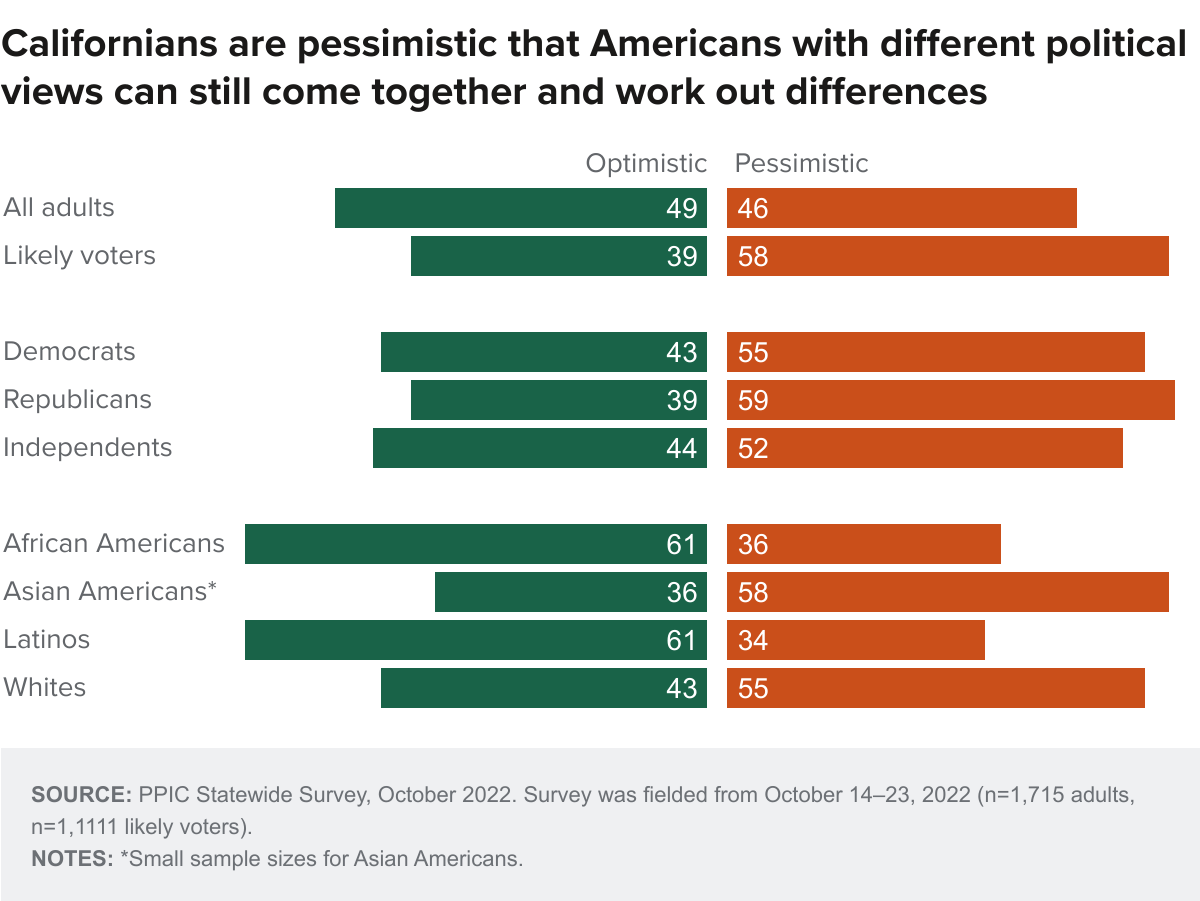
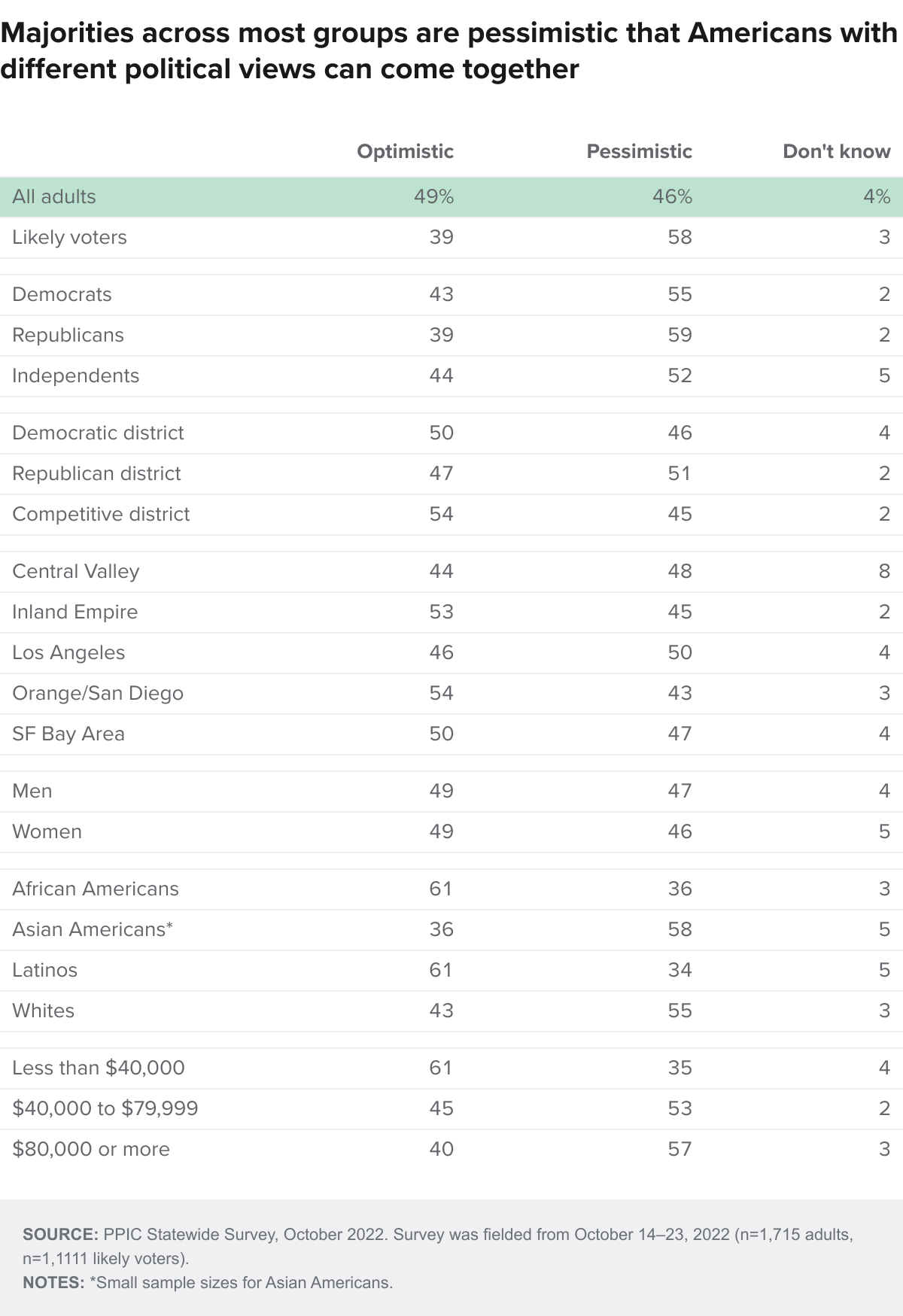
Approval Ratings
With about two weeks to go before Governor Newsom’s bid for reelection, a majority of Californians (54%) and likely voters (52%) approve of the way he is handling his job, while fewer disapprove (33% adults, 45% likely voters). Approval was nearly identical in September (52% adults, 55% likely voters) and has been 50 percent or more since January 2020. Today, about eight in ten Democrats—compared to about half of independents and about one in ten Republicans—approve of Governor Newsom. Half or more across regions approve of Newsom, except in the Central Valley (42%). Across demographic groups, about half or more approve of how Governor Newsom is handling his job.
With all 80 state assembly positions and half of state senate seats up for election, fewer than half of adults (49%) and likely voters (43%) approve of the way that the California Legislature is handling its job. Views are deeply divided along partisan lines; approval is highest in the San Francisco Bay Area and lowest in Orange/San Diego. About half across racial/ethnic groups approve, and approval is much higher among younger Californians.
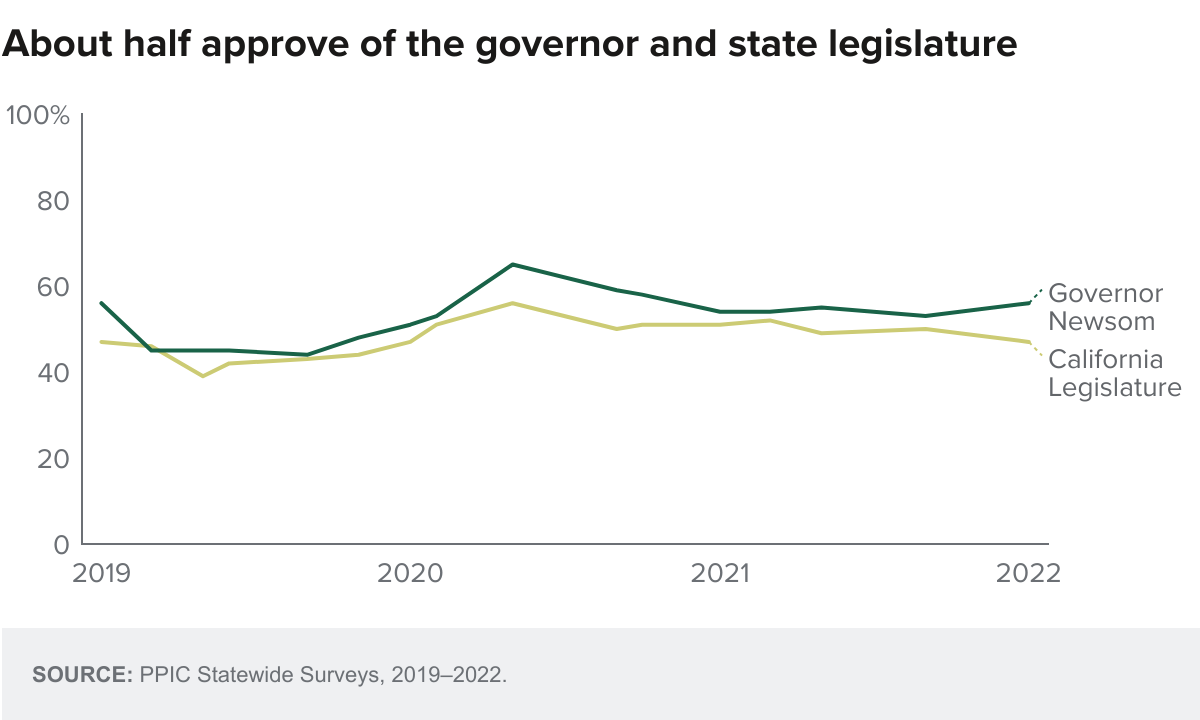
Majorities of California adults (53%) and likely voters (52%) approve of the way President Biden is handling his job, while fewer disapprove (43% adults, 47% likely voters). Approval is similar to September (53% adults and likely voters), and Biden’s approval rating among adults has been at 50 percent or higher since we first asked this question in January 2021. Today, about eight in ten Democrats approve of Biden’s job performance, compared to about four in ten independents and one in ten Republicans. Approval is higher in the San Francisco Bay Area and Los Angeles than in the Inland Empire, Orange/San Diego, and the Central Valley. About half or more across demographic groups approve of President Biden, with the exception of those with some college education (44%).
Approval of Congress remains low, with fewer than four in ten adults (37%) and likely voters (29%) approving. Approval of Congress among adults has been below 40 percent for all of 2022 after seeing a brief run above 40 percent for all of 2021. Democrats are far more likely than Republicans to approve of Congress. Fewer than half across regions and demographic groups approve of Congress.
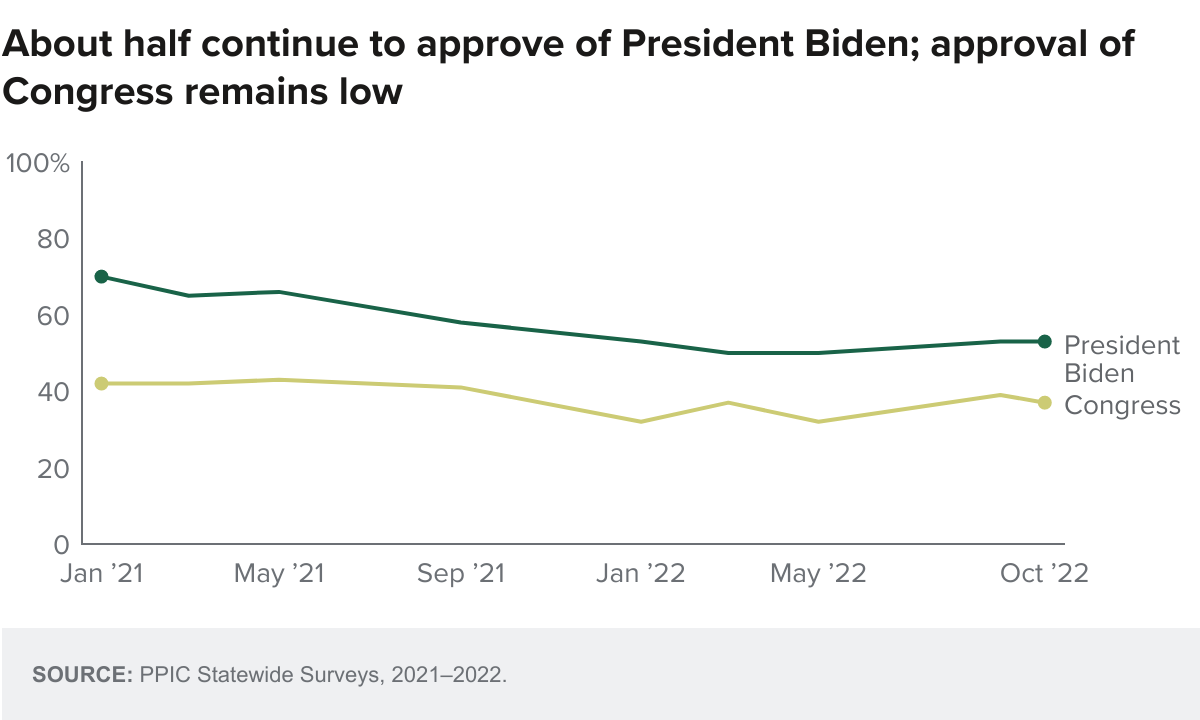
US Senator Alex Padilla is on the California ballot twice this November—once for the remainder of Vice President Harris’s term and once for reelection. Senator Padilla has the approval of 46 percent of adults and 48 percent of likely voters (adults: 26% disapprove, 29% don’t know; likely voters: 31% disapprove, 22% don’t know). Approval in March was at 44 percent for adults and 39 percent for likely voters. Today, Padilla’s approval rating is much higher among Democrats than independents and Republicans. Across regions, about half in the San Francisco Bay Area, Los Angeles, and the Inland Empire approve of the US senator, compared to four in ten in Orange/San Diego and one in three in the Central Valley. Across demographic groups, about half or more approve among women, younger adults, African Americans, Asian Americans, and Latinos. Views are similar across education and income groups, with just fewer than half approving.
US Senator Dianne Feinstein—who is not on the California ballot this November—has the approval of 41 percent of adults and likely voters (adults: 42% disapprove, 17% don’t know; likely voters: 52% disapprove, 7% don’t know). Approval in March was at 41 percent for adults and 36 percent for likely voters. Today, Feinstein’s approval rating is far higher among Democrats and independents than Republicans. Across regions, approval reaches a majority only in the San Francisco Bay Area. Across demographic groups, approval reaches a majority only among African Americans
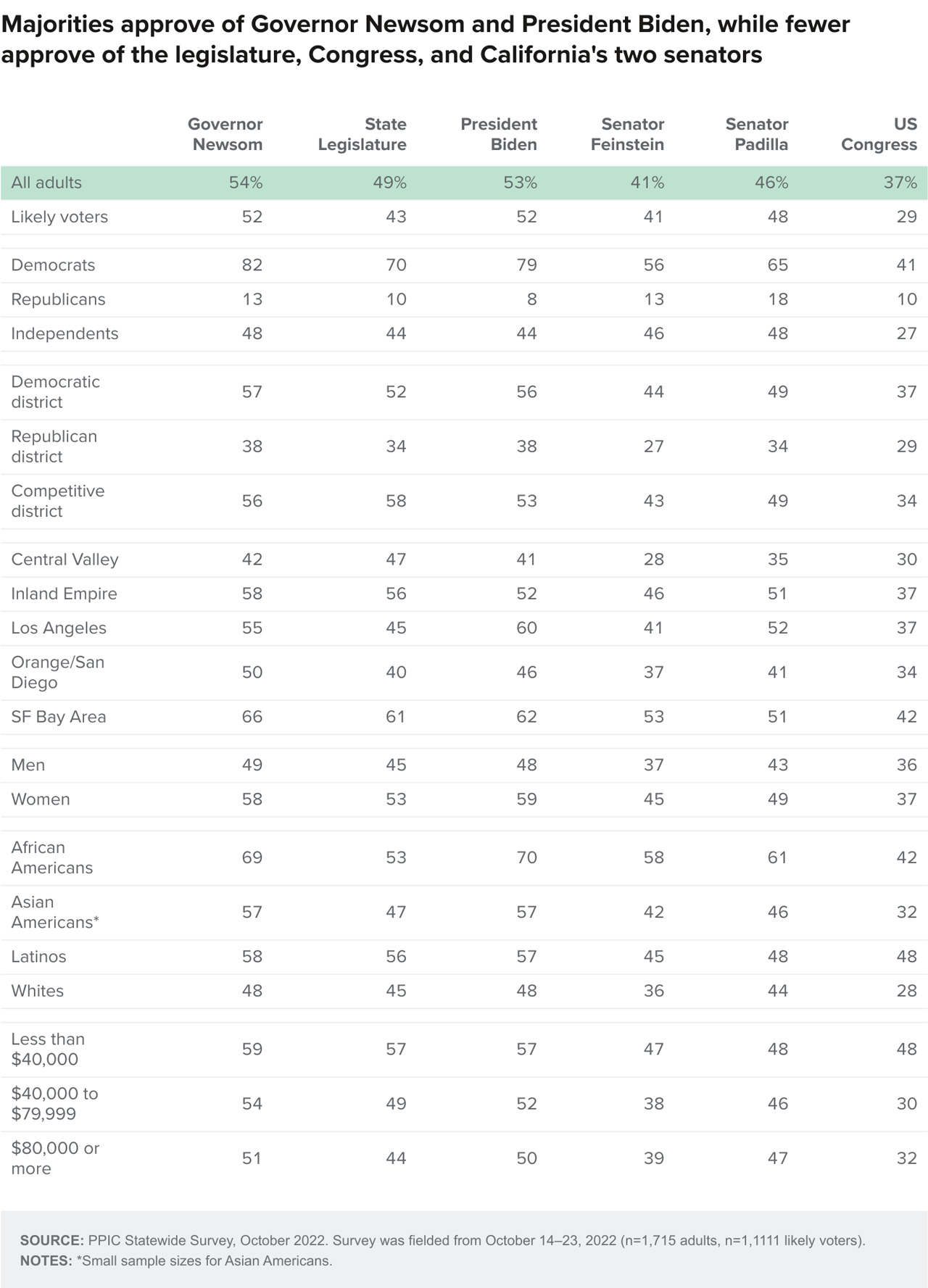
Regional Map
This map highlights the five geographic regions for which we present results; these regions account for approximately 90 percent of the state population. Residents of other geographic areas (in gray) are included in the results reported for all adults, registered voters, and likely voters, but sample sizes for these less-populous areas are not large enough to report separately.
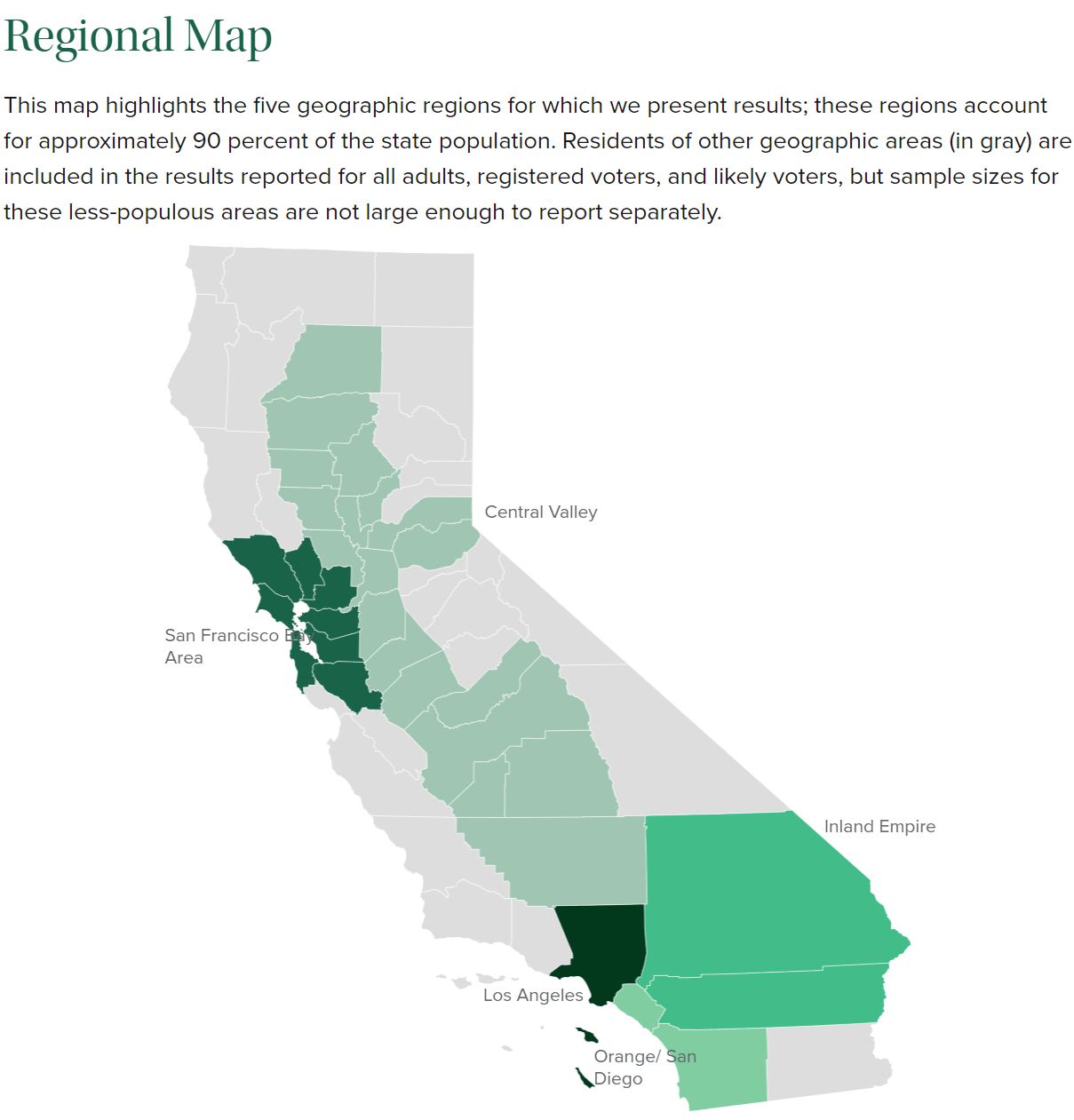
Methodology
The PPIC Statewide Survey is directed by Mark Baldassare, president and CEO and survey director at the Public Policy Institute of California. Coauthors of this report include survey analyst Deja Thomas, who was the project manager for this survey; associate survey director and research fellow Dean Bonner; and survey analyst Rachel Lawler. The Californians and Their Government survey is supported with funding from the Arjay and Frances F. Miller Foundation and the James Irvine Foundation. The PPIC Statewide Survey invites input, comments, and suggestions from policy and public opinion experts and from its own advisory committee, but survey methods, questions, and content are determined solely by PPIC’s survey team.
Findings in this report are based on a survey of 1,715 California adult residents, including 1,263 interviewed on cell phones and 452 interviewed on landline telephones. The sample included 569 respondents reached by calling back respondents who had previously completed an interview in PPIC Statewide Surveys in the last six months. Interviews took an average of 19 minutes to complete. Interviewing took place on weekend days and weekday nights from October 14–23, 2022.
Cell phone interviews were conducted using a computer-generated random sample of cell phone numbers. Additionally, we utilized a registration-based sample (RBS) of cell phone numbers for adults who are registered to vote in California. All cell phone numbers with California area codes were eligible for selection. After a cell phone user was reached, the interviewer verified that this person was age 18 or older, a resident of California, and in a safe place to continue the survey (e.g., not driving). Cell phone respondents were offered a small reimbursement to help defray the cost of the call. Cell phone interviews were conducted with adults who have cell phone service only and with those who have both cell phone and landline service in the household.
Landline interviews were conducted using a computer-generated random sample of telephone numbers that ensured that both listed and unlisted numbers were called. Additionally, we utilized a registration-based sample (RBS) of landline phone numbers for adults who are registered to vote in California. All landline telephone exchanges in California were eligible for selection. After a household was reached, an adult respondent (age 18 or older) was randomly chosen for interviewing using the “last birthday method” to avoid biases in age and gender.
For both cell phones and landlines, telephone numbers were called as many as eight times. When no contact with an individual was made, calls to a number were limited to six. Also, to increase our ability to interview Asian American adults, we made up to three additional calls to phone numbers estimated by Survey Sampling International as likely to be associated with Asian American individuals.
Live landline and cell phone interviews were conducted by Abt Associates in English and Spanish, according to respondents’ preferences. Accent on Languages, Inc., translated new survey questions into Spanish, with assistance from Renatta DeFever.
Abt Associates uses the US Census Bureau’s 2016–2020 American Community Survey’s (ACS) Public Use Microdata Series for California (with regional coding information from the University of Minnesota’s Integrated Public Use Microdata Series for California) to compare certain demographic characteristics of the survey sample—region, age, gender, race/ethnicity, and education—with the characteristics of California’s adult population. The survey sample was closely comparable to the ACS figures. To estimate landline and cell phone service in California, Abt Associates used 2019 state-level estimates released by the National Center for Health Statistics—which used data from the National Health Interview Survey (NHIS) and the ACS. The estimates for California were then compared against landline and cell phone service reported in this survey. We also used voter registration data from the California Secretary of State to compare the party registration of registered voters in our sample to party registration statewide. The landline and cell phone samples were then integrated using a frame integration weight, while sample balancing adjusted for differences across region, age, gender, race/ethnicity, education, telephone service, and party registration groups.
The sampling error, taking design effects from weighting into consideration, is ±3.9 percent at the 95-percent confidence level for the total unweighted sample of 1,715 adults. This means that 95 times out of 100, the results will be within 3.9 percentage points of what they would be if all adults in California were interviewed. The sampling error for unweighted subgroups is larger: for the 1,439 registered voters, the sampling error is ±4.5 percent; for the 1,111 likely voters, it is ±5.1 percent. For the sampling errors of additional subgroups, please see the table at the end of this section. Sampling error is only one type of error to which surveys are subject. Results may also be affected by factors such as question wording, question order, and survey timing.
We present results for five geographic regions, accounting for approximately 90 percent of the state population. “Central Valley” includes Butte, Colusa, El Dorado, Fresno, Glenn, Kern, Kings, Madera, Merced, Placer, Sacramento, San Joaquin, Shasta, Stanislaus, Sutter, Tehama, Tulare, Yolo, and Yuba Counties. “San Francisco Bay Area” includes Alameda, Contra Costa, Marin, Napa, San Francisco, San Mateo, Santa Clara, Solano, and Sonoma Counties. “Los Angeles” refers to Los Angeles County, “Inland Empire” refers to Riverside and San Bernardino Counties, and “Orange/San Diego” refers to Orange and San Diego Counties. Residents of other geographic areas are included in the results reported for all adults, registered voters, and likely voters, but sample sizes for these less-populous areas are not large enough to report separately. We also present results for congressional districts currently held by Democrats or Republicans, based on residential zip code and party of the local US House member. We analyze the results of those who live in competitive house districts as determined by the Cook Political Report’s 2022 House Race Ratings updated September 1, 2022. These districts are 3, 9, 13, 22, 27, 40, 41, 45, 47, and 49; a map of California’s congressional districts can be found here.
We present results for non-Hispanic whites, who account for 41 percent of the state’s adult population, and also for Latinos, who account for about a third of the state’s adult population and constitute one of the fastest-growing voter groups. We also present results for non-Hispanic Asian Americans, who make up about 16 percent of the state’s adult population, and non-Hispanic African Americans, who comprise about 6 percent. Results for other racial/ethnic groups—such as Native Americans—are included in the results reported for all adults, registered voters, and likely voters, but sample sizes are not large enough for separate analysis. Results for African American and Asian American likely voters are combined with those of other racial/ethnic groups because sample sizes for African American and Asian American likely voters are too small for separate analysis. We compare the opinions of those who report they are registered Democrats, registered Republicans, and no party preference or decline-to-state or independent voters; the results for those who say they are registered to vote in other parties are not large enough for separate analysis. We also analyze the responses of likely voters—so designated per their responses to survey questions about voter registration, previous election participation, intentions to vote this year, attention to election news, and current interest in politics.
The percentages presented in the report tables and in the questionnaire may not add to 100 due to rounding.
Numerous questions were adapted from national surveys by ABC News/Washington Post, CBS News, NPR/PBS NewsHour/Marist, and the Pew Research Center. Additional details about our methodology can be found at www.ppic.org/wp-content/uploads/SurveyMethodology.pdf and are available upon request through surveys@ppic.org.
Questions and Responses
October 14–23, 2022
1,715 California adult residents; 1,111 California likely voters
English, Spanish
Margin of error ±3.9% at 95% confidence level for the total sample, ±5.1% for likely voters. Percentages may not add up to 100 due to rounding.
1. Overall, do you approve or disapprove of the way that Gavin Newsom is handling his job as governor of California?
54% approve
33% disapprove
14% don’t know
2. Overall, do you approve or disapprove of the way that the California Legislature is handling its job?
49% approve
37% disapprove
14% don’t know
3. Do you think things in California are generally going in the right direction or the wrong direction?
47% right direction
48% wrong direction
5% don’t know
4. Thinking about your own personal finances—would you say that you and your family are financially better off, worse off, or just about the same as a year ago?
17% better off
39% worse off
43% same
1% don’t know
5. Next, some people are registered to vote and others are not. Are you absolutely certain that you are registered to vote in California?
74% yes [ask q5a]
26% no [skip to q6b]
5a. Are you registered as a Democrat, a Republican, another party, or are you registered as a decline-to-state or independent voter?
47% Democrat [ask q6]
24% Republican [ask q6a]
6% another party (specify) [skip to q7]
23% decline-to-state/independent [skip to 6b]
[likely voters only]
47% Democrat [ask q6]
27% Republican [ask q6a]
5% another party (specify) [skip to q7]
20% decline-to-state/independent [skip to 6b]
6. Would you call yourself a strong Democrat or not a very strong Democrat?
61% strong
37% not very strong
2% don’t know
[skip to q7]
6a. Would you call yourself a strong Republican or not a very strong Republican?
60% strong
38% not very strong
2% don’t know
[skip to q7]
6b. Do you think of yourself as closer to the Republican Party or Democratic Party?
23% Republican Party
44% Democratic Party
24% neither (volunteered)
9% don’t know
7. [likely voters only] If the November 8th election for governor were being held today, would you vote for [rotate] [1] Brian Dahle, a Republican, [or] [2] Gavin Newsom, a Democrat?
36% Brian Dahle, a Republican
55% Gavin Newsom, a Democrat
4% neither/would not vote for governor (volunteered)
5% don’t know
8. [likely voters only] How closely are you following news about candidates for the 2022 governor’s election—very closely, fairly closely, not too closely, or not at all closely?
25% very closely
35% fairly closely
25% not too closely
15% not at all closely
– don’t know
9. [likely voters only] In general, would you say you are satisfied or not satisfied with your choices of candidates in the election for governor on November 8th?
62% satisfied
32% not satisfied
6% don’t know
Changing topics,
10. [likely voters only] If the 2022 election for US House of Representatives were being held today, would you vote for [rotate] [1] the Republican candidate [or] [2] the Democratic candidate in your district? (ask if ‘other’ or ‘don’t know’: “As of today, do you lean more toward [read in same order as above] [1] the Republican candidate [or] [2] the Democratic candidate?”)
39% Republican/lean Republican
56% Democrat/lean Democrat
5% don’t know
11. [likely voters only] How important is the issue of abortion rights in your vote for Congress this year—is it very important, somewhat important, not too important, or not at all important?
61% very important
20% somewhat important
7% not too important
10% not at all important
– don’t know
12. [likely voters only] How enthusiastic would you say you are about voting for Congress this year—extremely enthusiastic, very enthusiastic, somewhat enthusiastic, not too enthusiastic, or not at all enthusiastic?
18% extremely enthusiastic
33% very enthusiastic
29% somewhat enthusiastic
14% not too enthusiastic
5% not at all enthusiastic
1% don’t know
Next, we have a few questions to ask you about some of the propositions on the November ballot.
13. [likely voters only] There are five citizens’ initiatives, one referendum, and one legislative constitutional amendment on the November 8 state ballot. Which one of the seven state propositions on the November 8 ballot are you most interested in?
20% Proposition 1 Constitutional Right to Reproductive Freedom, Abortion, Contraceptives
4% Proposition 26 Sports Betting at Tribal Casinos
10% Proposition 27 Allow Online Sports Betting
2% Proposition 28 Arts and Music Education Funding in Public Schools
7% Proposition 29 Impose New Rules on Dialysis Clinics
4% Proposition 30 Tax Millionaires for Electric Vehicle Programs, Wildfire Response and Prevention
3% Proposition 31 Uphold Flavored Tobacco Ban
11% none of them (volunteered)
4% all equally (volunteered)
1% other (specify) (volunteered)
33% don’t know
14. [likely voters only] Proposition 26 is called Allows In-Person Roulette, Dice Game, Sports Wagering on Tribal Lands. Initiative Constitutional Amendment and Statute. It allows in-person sports betting at racetracks and tribal casinos, and requires that racetracks and casinos that offer sports betting to make certain payments to the state—such as to support state regulatory costs. The fiscal impact is increased state revenues, possibly reaching tens of millions of dollars annually. Some of these revenues would support increased state regulatory and enforcement costs that could reach the low tens of millions of dollars annually. If the election were held today, would you vote yes or no on Proposition 26?
34% yes
57% no
9% don’t know
15. [likely voters only] How important to you is the outcome of the vote on Proposition 26—is it very important, somewhat important, not too important, or not at all important?
21% very important
37% somewhat important
26% not too important
11% not at all important
5% don’t know
Next,
16. [likely voters only] Proposition 27 is called Allows Online and Mobile Sports Wagering Outside Tribal Lands. Initiative Constitutional Amendment. It allows Indian tribes and affiliated businesses to operate online and mobile sports wagering outside tribal lands. It directs revenues to regulatory costs, homelessness programs, and nonparticipating tribes. The fiscal impact is increased state revenues, possibly in the hundreds of millions of dollars but not likely to exceed $500 million annually. Some revenues would support state regulatory costs, possibly reaching the mid-tens of millions of dollars annually. If the election were held today, would you vote yes or no on Proposition 27?
26% yes
67% no
8% don’t know
17. [likely voters only] How important to you is the outcome of the vote on Proposition 27—is it very important, somewhat important, not too important, or not at all important?
31% very important
34% somewhat important
22% not too important
9% not at all important
4% don’t know
18. [likely voters only] Would you say you are personally interested in betting on sports, or not?
9% yes, interested
90% no, not interested
– don’t know
19. [likely voters only] Thinking about the fact that betting money on sports is now legal in most of the country—if sports betting was made legal in California, do you think this would be a good thing or bad thing for the state?
30% good thing
48% bad thing
11% neither a good thing nor bad thing, doesn’t matter (volunteered)
11% don’t know
Next,
20. [likely voters only] Proposition 30 is called Provides Funding for Programs to Reduce Air Pollution and Prevent Wildfires by Increasing Tax on Personal Income over $2 Million. Initiative Statute. It allocates tax revenues to zero-emission vehicle purchase incentives, vehicle charging stations, and wildfire prevention. The fiscal impact is increased state tax revenue ranging from $3.5 billion to $5 billion annually, with the new funding used to support zero-emission vehicle programs and wildfire response and prevention activities. If the election were held today, would you vote yes or no on Proposition 30?
41% yes
52% no
7% don’t know
21. [likely voters only] How important to you is the outcome of the vote on Proposition 30—is it very important, somewhat important, not too important, or not at all important?
42% very important
38% somewhat important
13% not too important
4% not at all important
3% don’t know
Next, we are interested in your opinions about the citizens’ initiatives and referenda that appear on the state ballot as propositions this fall. Do you agree or disagree with these statements?
[rotate questions 22 and 23]
22. [likely voters only] There are too many propositions on the state ballot—do you strongly agree, somewhat agree, somewhat disagree, or strongly disagree?
20% strongly agree
27% somewhat agree
27% somewhat disagree
22% strongly disagree
5% don’t know
23. [likely voters only] The propositions on the state ballot reflect the concerns of average California residents—do you strongly agree, somewhat agree, somewhat disagree, or strongly disagree?
14% strongly agree
36% somewhat agree
25% somewhat disagree
21% strongly disagree
4% don’t know
Reforms have been suggested to address issues in California’s direct democracy process.
24. [likely voters only] Would you favor or oppose a new law that would increase the number of signatures required to qualify an initiative, referendum, or recall for the state ballot?
43% favor
46% oppose
10% don’t know
25. [likely voters only] Would you favor or oppose a new law that would allow electronic signature gathering over the internet to qualify an initiative, referendum, or recall for the state ballot?
31% favor
64% oppose
5% don’t know
Changing topics,
26. Overall, do you approve or disapprove of the way that Joe Biden is handling his job as president?
53% approve
43% disapprove
4% don’t know
[rotate questions 27 and 28]
27. Overall, do you approve or disapprove of the way Alex Padilla is handling his job as US Senator?
46% approve
26% disapprove
29% don’t know
28. Overall, do you approve or disapprove of the way Dianne Feinstein is handling her job as US Senator?
41% approve
42% disapprove
17% don’t know
29. Overall, do you approve or disapprove of the way the US Congress is handling its job?
37% approve
57% disapprove
7% don’t know
Next,
30. Do you think things in the United States are generally going in the right direction or the wrong direction?
33% right direction
62% wrong direction
5% don’t know
31. Would you describe the state of the nation’s economy these days as excellent, good, not so good, or poor?
3% excellent
20% good
43% not so good
33% poor
1% don’t know
Next,
32. How satisfied are you with the way democracy is working in the United States? Are you very satisfied, somewhat satisfied, not too satisfied, or not at all satisfied?
7% very satisfied
38% somewhat satisfied
29% not too satisfied
23% not at all satisfied
2% don’t know
33. These days, do you feel [rotate] [1] (optimistic) [or] [2] (pessimistic) that Americans of different political views can still come together and work out their differences?
49% optimistic
46% pessimistic
4% don’t know
On another topic,
34. What is your opinion with regard to race relations in the United States today? Would you say things are [rotate 1 and 2] [1] (better), [2] (worse), or about the same than they were a year ago?
20% better
35% worse
44% about the same
2% don’t know
35. When it comes to racial discrimination, which do you think is the bigger problem for the country today—[rotate] [1] People seeing racial discrimination where it really does NOT exist [or] [2] People NOT seeing racial discrimination where it really DOES exist?
37% people seeing racial discrimination where it really does not exist
54% people not seeing racial discrimination where it really does exist
9% don’t know
Next,
36. Next, would you consider yourself to be politically: [read list, rotate order top to bottom]
17% very liberal
19% somewhat liberal
29% middle-of-the-road
20% somewhat conservative
12% very conservative
3% don’t know
37. Generally speaking, how much interest would you say you have in politics—a great deal, a fair amount, only a little, or none?
26% great deal
37% fair amount
28% only a little
8% none
-% don’t know
[d1–d15 demographic questions]
Authors
Mark Baldassare is president and CEO of the Public Policy Institute of California, where he holds the Arjay and Frances Fearing Miller Chair in Public Policy. He is a leading expert on public opinion and survey methodology, and has directed the PPIC Statewide Survey since 1998. He is an authority on elections, voter behavior, and political and fiscal reform, and the author of ten books and numerous publications. Previously, he served as PPIC’s director of research and senior fellow. Before joining PPIC, he was a professor of urban and regional planning in the School of Social Ecology at the University of California, Irvine, where he held the Johnson Chair in Civic Governance. He has conducted surveys for the Los Angeles Times, the San Francisco Chronicle, and the California Business Roundtable. He holds a PhD in sociology from the University of California, Berkeley.
Dean Bonner is associate survey director and research fellow at PPIC, where he coauthors the PPIC Statewide Survey—a large-scale public opinion project designed to develop an in-depth profile of the social, economic, and political attitudes at work in California elections and policymaking. He has expertise in public opinion and survey research, political attitudes and participation, and voting behavior. Before joining PPIC, he taught political science at Tulane University and was a research associate at the University of New Orleans Survey Research Center. He holds a PhD and MA in political science from the University of New Orleans.
Rachel Lawler is a survey analyst at the Public Policy Institute of California, where she works with the statewide survey team. Prior to joining PPIC, she was a client manager in Kantar Millward Brown’s Dublin, Ireland office. In that role, she led and contributed to a variety of quantitative and qualitative studies for both government and corporate clients. She holds an MA in American politics and foreign policy from the University College Dublin and a BA in political science from Chapman University.
Deja Thomas is a survey analyst at the Public Policy Institute of California, where she works with the statewide survey team. Prior to joining PPIC, she was a research assistant with the social and demographic trends team at the Pew Research Center. In that role, she contributed to a variety of national quantitative and qualitative survey studies. She holds a BA in psychology from the University of Hawaiʻi at Mānoa.
Acknowledgments
This survey was supported with funding from the Arjay and Frances F. Miller Foundation and the James Irvine Foundation.
PPIC Statewide Advisory Committee
Ruben Barrales
Senior Vice President, External Relations
Wells Fargo
Angela Glover Blackwell
Founder in Residence
PolicyLink
Mollyann Brodie
Executive Vice President and
Chief Operating Officer
Henry J. Kaiser Family Foundation
Bruce E. Cain
Director
Bill Lane Center for the American West
Stanford University
Jon Cohen
Chief Research Officer and Senior Vice President,
Strategic Partnerships and Business Development
Momentive-AI
Joshua J. Dyck
Co-Director
Center for Public Opinion
University of Massachusetts, Lowell
Lisa García Bedolla
Vice Provost for Graduate Studies and
Dean of the Graduate Division
University of California, Berkeley
Russell Hancock
President and CEO
Joint Venture Silicon Valley
Sherry Bebitch Jeffe
Professor
Sol Price School of Public Policy
University of Southern California
Robert Lapsley
President
California Business Roundtable
Carol S. Larson
President Emeritus
The David and Lucile Packard Foundation
Donna Lucas
Chief Executive Officer & Founder
Lucas Public Affairs
Sonja Petek
Fiscal and Policy Analyst
California Legislative Analyst’s Office
Lisa Pitney
Vice President of Government Relations
The Walt Disney Company
Robert K. Ross, MD
President and CEO
The California Endowment
Jui Shrestha
Survey Specialist Consultant
World Bank
Most Reverend Jaime Soto
Bishop of Sacramento
Roman Catholic Diocese of Sacramento
Helen Iris Torres
CEO
Hispanas Organized for Political Equality
David C. Wilson, PhD
Dean and Professor
Richard and Rhoda Goldman School
of Public Policy
University of California, Berkeley
PPIC Board of Directors
Chet Hewitt, Chair
President and CEO
Sierra Health Foundation
Mark Baldassare
President and CEO
Public Policy Institute of California
Ophelia Basgal
Affiliate
Terner Center for Housing Innovation
University of California, Berkeley
Louise Henry Bryson
Chair Emerita, Board of Trustees
J. Paul Getty Trust
Sandra Celedon
President and CEO
Fresno Building Healthy Communities
A. Marisa Chun
Judge, Superior Court of California, County of San Francisco
Phil Isenberg
Former Chair
Delta Stewardship Council
Mas Masumoto
Author and Farmer
Steven A. Merksamer
Of Counsel
Nielsen Merksamer Parrinello
Gross & Leoni LLP
Steven J. Olson
Partner
O’Melveny & Myers LLP
Leon E. Panetta
Chairman
The Panetta Institute for Public Policy
Gerald L. Parsky
Chairman
Aurora Capital Group
Kim Polese
Chairman and Co-founder
CrowdSmart
Cassandra Walker Pye
President
Lucas Public Affairs
Helen Iris Torres
CEO
Hispanas Organized for Political Equality
Gaddi H. Vasquez
Retired Senior Vice President, Government Affairs
Edison International
Southern California Edison
Copyright
© 2022 Public Policy Institute of California
The Public Policy Institute of California is dedicated to informing and improving public policy in California through independent, objective, nonpartisan research.
PPIC is a public charity. It does not take or support positions on any ballot measures or on any local, state, or federal legislation, nor does it endorse, support, or oppose any political parties or candidates for public office.
Short sections of text, not to exceed three paragraphs, may be quoted without written permission provided that full attribution is given to the source.
Research publications reflect the views of the authors and do not necessarily reflect the views of our funders or of the staff, officers, advisory councils, or board of directors of the Public Policy Institute of California.
PlayStation userbase “significantly larger” than Xbox even if every COD player ditched Sony, Microsoft says

Microsoft has responded to a list of concerns regarding its ongoing $68bn attempt to buy Activision Blizzard, as raised by the UK’s Competition and Markets Authority (CMA), and come up with an interesting statistic.
In response to continued questions over whether Microsoft owning Call of Duty would unfairly hobble PlayStation, Microsoft claimed that every COD player on PlayStation could move over to Xbox, and Sony’s playerbase would still remain “significantly larger” than its own.
Microsoft does not go into detail on its mental arithmetic here, but does note elswhere in its comments that PlayStation currently has a console install base of 150 million, compared to Xbox’s install base of 63.7 million.
That claim is part of a range of comments given to Eurogamer sister site GamesIndustry.biz in response to the CMA’s latest report, which otherwise mostly repeats many of the same concerns raised by the UK regulator – and others around the world – already.
For those following the case, the CMA’s latest intervention will not come as a surprise – it is the next step on the regulator’s recent roadmap for how and when it will weigh in with its final ruling. This month, we were due the CMA’s October “issues statement” – and it seems that this is the document to which Microsoft has now publicly responded.
The usual topics are covered – surrounding the potential for the deal to harm competitors should Microsoft gain too much of an advantage owning Activision Blizzard franchises (mainly, Call of Duty) and therefore being able to leverage their brand power to become a dominant market leader in the console market and cloud streaming.
Specifically, the CMA sees potential for the deal to harm Sony but also other streaming services such as Google (perhaps a moot point now), Amazon and Nvidia.
“Having full control over this powerful catalogue, especially in light of Microsoft’s already strong position in gaming consoles, operating systems, and cloud infrastructure, could result in Microsoft harming consumers by impairing Sony’s – Microsoft’s closest gaming rival – ability to compete,” the CMA wrote, “as well as that of other existing rivals and potential new entrants who could otherwise bring healthy competition through innovative multi-game subscriptions and cloud gaming services.”
In response, Microsoft said such “unsupported theories of harm” were not enough to even warrant the CMA’s current Phase 2 investigation – which was triggered on 1st September.
“The suggestion that the incumbent market leader, with clear and enduring market power, could be foreclosed by the third largest provider as a result of losing access to one title is not credible,” Microsoft told GamesIndustry.biz.
“While Sony may not welcome increased competition, it has the ability to adapt and compete. Gamers will ultimately benefit from this increased competition and choice.
“Should any consumers decide to switch from a gaming platform that does not give them a choice as to how to pay for new games (PlayStation) to one that does (Xbox), then that is the sort of consumer switching behavior that the CMA should consider welfare enhancing and indeed encourage. It is not something that the CMA should be trying to prevent.”
The CMA is due to notify Microsoft of its provisional findings in January 2023, at which point it can seek possible remedies to any sticking points raised. The regulator’s final report – and overall ruling – will then be published no later than 1st March next year.
Become a Eurogamer subscriber and get your first month for £1
Get your first month for £1 (normally £3.99) when you buy a Standard Eurogamer subscription. Enjoy ad-free browsing, merch discounts, our monthly letter from the editor, and show your support with a supporter-exclusive comment flair!
Tagged With
Subscribe to the Eurogamer.net Daily newsletter
Get the day’s most talked about stories straight to your inbox.
About the Author
Tom is Eurogamer’s deputy editor. He writes lots of news, some of the puns and makes sure we put the accent on Pokémon.
Source https://www.state.gov/countries-areas/south-africa/
Source https://www.ppic.org/publication/ppic-statewide-survey-californians-and-their-government-october-2022/
Source https://www.eurogamer.net/playstation-userbase-significantly-larger-than-xbox-even-if-every-cod-player-ditched-sony-microsoft-says